Germany
 From Rationalwiki
From Rationalwiki _-_DEU_-_UNOCHA.svg.png)
“”And now it's time for me to meet Europe's "cuddly teddybears"... the Germans. Germany as a country has only been in existence for just over a hundred years. But in that time they've started two world wars, they've had two military coups, they've been brought on the brink of starvation two times, and they've invaded almost all of their neighbours.
|
| —Jeremy Clarkson, Top Gear: Jeremy Meets the Neighbours.[1] |
Germany (German: Deutschland), officially known as the Federal Republic of Germany (Bundesrepublik Deutschland), is a country in Central Europe that has, in many ways, been the primary engine of that continent's tumultuous modern history. The country is famous internationally for being the economic powerhouse of the European Union bloc and is one of its most influential members.[2] Germany's gifts to the world are its excellent beer, sausages, automobiles, classical music, and picturesque castles.[3] Unfortunately, the country wasn't always so nice, and it's thus also known for its violent history, rife with savage, horrific brutality, imperialism, religious wars, and not to mention the myriad crimes of the Nazi regime, the Holocaust, and the tense national division during the Cold War. Today, however, Germany is a democratic republic with its capital located in its largest city, Berlin. Thankfully, Germans of today are much more likely to smoke a joint than a Jew.[4] The country is strongly secular, with 55% of the population identifying as Christian but only 10% saying they are sure God exists.[5] About 6% of its people are Muslim, and 28% are atheist or agnostic.[5]
During classical antiquity, Germany was inhabited by various tribes noted for their violent warrior culture. They became persistent thorns in the side of the Roman Empire, eventually helping to bring about the downfall of the western half in 476 CE. The Germans remained divided and largely pagan until the Frankish ruler Charlemagne completed the bloody process of conquering them in 800 CE. Upon his death, the empire split, and the eastern half went on as East Francia, eventually evolving into the Holy Roman Empire under the rule of Otto the Great in 962 CE.
As suggested by its name, the Holy Roman Empire had a close institutional relationship with the Catholic Church, and its politics were dominated by struggles between the emperors and the popes who wanted to control or dick them over. Political struggles naturally escalated into violence, plunging the empire into frequent civil wars and allowing ambitious local nobles to accumulate power for themselves at the expense of the empire's cohesion. Not a recipe for long-term success. Despite the empire's decentralization, it remained a significant force in European politics. German nobles and knights participated in various events in the Crusades, which helped Germany's borders spread further eastward. Over time, the Hapsburgs of Austria, one of the empire's noble families, came to dominate the empire's politics and consistently placed their rulers on its throne.
In 1517, German theologian Martin Luther started the Protestant Reformation by criticizing the Catholic Church. Local nobles saw the movement as an excuse to further distance themselves from the empire's central authority. Conflicts between Protestant princes and the Catholic empire were just as inevitable, bloody, and ultimately pointless as religious wars always are. They culminated in 1618 with the Thirty Years' War, a horrifying shit hurricane that killed millions, devastated Germany's economy, and destroyed most remaining elements of imperial authority and papal influence over imperial politics. Afterward, Austria focused on growing its own domains outside of the empire while various German states started to grow unchecked.
From 1740, the Kingdom of Prussia, which ruled from Berlin, became the dominant power in northern Germany thanks to its extreme militarism. It repeatedly clashed with Austria before teaming up with them against Napoleon Bonaparte. However, they were unsuccessful in stopping him, and the Holy Roman Empire was dissolved in 1806. After Napoleon's downfall, Austria and Prussia remained great powers and grappled with each other because that's just what powerful countries do.
Amid the modern trends of the early 19th century, the question of German unification arose: the nationalist idea that the various independent German states left behind by the old empire should be united into a single German state. Prussian statesman Otto von Bismarck eventually made it happen, first by beating up Austria to control southern Germany and exclude Austria from unification, then by waging a short and brutal war against France in 1870 to solidify Prussia's status as a superpower and convince the German states to accept annexation. Over the defeated French in Versailles, Bismarck and the Prussian king proclaimed the German Empire, which charted a conservative path under Bismarck, establishing universal healthcare to keep the population pacified. It eventually joined the Scramble for Africa while throwing in some native genocides for extra measure.
The German Empire was ultimately dismantled after World War I, leading to a period of political and economic crisis and a failed democracy called the Weimar Republic. The Austrian-born Adolf Hitler rose to prominence during this period after participating in a dumb failed coup and writing a shitty book, eventually seizing power and turning Germany into Nazi Germany while annexing a bunch of its neighbors. He then launched Germany into World War II, devastating Europe and committing genocide against Jews, Roma, and other groups of people he hated for existing. Hitler's stupid war backfired, leaving Germany stripped of its eastern possessions and split between the Soviet Union's puppet of East Germany and the Western-aligned democracy of West Germany.
Some nerve-wracking brinksmanship and hostile relations later, and East Germany reunified with the west in 1990 after the general collapse of the Eastern Bloc. Since then, modern Germany has focused on reintegrating its eastern regions while building its economy. Unfortunately, it's been challenged by a resurgent far-right and problems associated with accepting Muslim refugees from the Middle East.
History[edit]
Antiquity[edit]
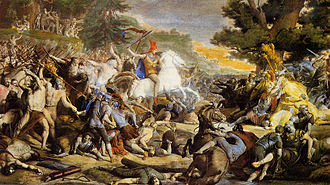
Germanic tribes[edit]
The Germanic tribes, probably from along the Baltic coast, spread throughout central Europe during the classical era. By the time of Julius Caesar, they had reached the frontiers of the Roman Empire, divided from it by the Rhine and Danube rivers.[6] The Romans reviled the Germans as warlike barbarians (probably a mostly fair assessment), and Caesar clashed several times with the Suebi tribe during his campaigns in France (then known as Gaul).[7]
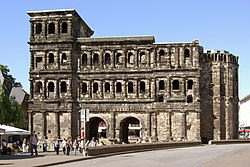
The Romans repeatedly launched campaigns against the Germanic tribes, putting a great deal of effort into dominating them and keeping them divided while attempting to colonize the Rhineland. This proceeded bloodily but successfully for centuries until the effort was passed to Roman governor Publius Quinctilius Varus, a tyrant. He demanded heavy taxes from the Germans and punished dissent harshly.[8] As tends to happen, the oppressed people decided that they'd had enough of that shit and rebelled against the leadership of Romanized Germanic noble Arminius.[8] In 9 CE, Arminius' rebel force lured Varus and his Romans into the deep Teutoburg Forest, massacring the Romans completely despite being heavily outnumbered.[9] Although the Romans launched multiple punitive attacks against the Germans, they never again tried to conquer Germany.
The Romans had such a hard time with the Germans for many reasons. Germanic warfare focused on the love of the art, with multiple pagan gods exalting war and warriors.[10] In contrast to the Roman concept of pitched battles, Germans focused on raids to capture resources and show off their fighting skills. Germanic tribal chieftains were expected to be warriors with lots of machismo, and their followers fought for them in exchange for a share of loot and land.[10] This militant relationship eventually went on to become the basis of the more complex system of feudalism.
Migration period[edit]
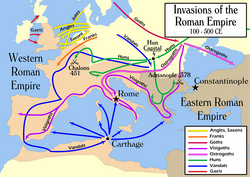
Under pressure from many sides, the Western Roman Empire slid into a period of decline in the fourth and fifth centuries. The Germans, meanwhile, came under attack from migrating groups from Central Asia and their own population growth, which pushed the Germans to seek new homes in different regions of Europe.[10] This generally caused chaos across Europe, as them damn German illegal immigrants caused trouble wherever they went. The Frankish tribe conquered Gaul, Vandals and Visigoths pushed into Hispania, Saxons moved to Great Britain, and the Alamanni took over the Rhineland.[10] In all places, the Western Roman Empire was hacked apart by Germanic warriors who seized lands and built permanent settlements upon them.
This process spelled doom for the Western Roman Empire. This was especially true when the Franks took over Roman-held Gaul, which had been the primary agricultural production breadbasket of the empire.[11] Its loss wrecked the Roman economy and destroyed the empire's remaining ability to defend itself. In 476 CE, German chief Odoacer deposed the child emperor Romulus Augustulus, declaring himself the new leader of Italy and formally ending the Western Roman Empire.[12] Oh, those Germans.
Early Middle Ages[edit]
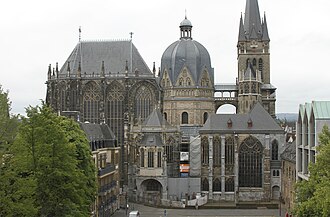
Under the Franks[edit]
Over in France, the Germanic Franks founded the first true Germanic state. Clovis I, the founder of the Frankish kingdom, converted to Christianity in 496 CE and began the conquest of central Europe by defeating the Alemanni.[13] Clovis attributed the victory to divine intervention, becoming a zealous Catholic. He and his successors sent priests from the church into Germany, most notably Winfrid, who became known as Saint Boniface for shaping the nature of German Catholicism and establishing a political alliance between the Franks and the Catholic Church.[14]
In 768 CE, Charlemagne inherited the Frankish crown and used much of his reign to extend the borders of the Frankish kingdom outwards to encompass most of Germany. Charlemagne's conquests were brutal, especially against the pagans of northern Saxony, many of whom he had massacred in retaliation for resisting him.[15] What a guy. For his service to the Catholic Church, Charlemagne was crowned Emperor of the Franks by the pope himself in 800 CE, choosing to rule his empire from the German city of Aachen. He commissioned one of the world's oldest cathedrals in that city, which formed part of his palace and became his final resting place.[16]
After Charlemagne's death, his empire was divided among his son, as was the custom of the era and known to all Crusader Kings players who've had their games ruined by a bad succession. The heirs promptly warred against each other until 843 CE, when the empire was finally divided for good between West Francia (which would become France) and East Francia (which would become the Holy Roman Empire).[17]
The First Reich[edit]
“”This agglomeration which was called and which still calls itself the Holy Roman Empire was neither holy, nor Roman, nor an empire.
|
| —The obligatory Voltaire quote[18] |
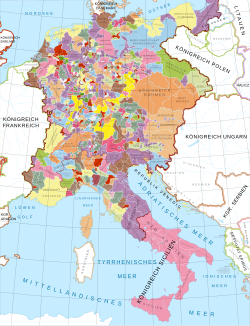
The empire at its height around 1200 CE, showing imperial states
.svg.png)
Imperial banner from 1430
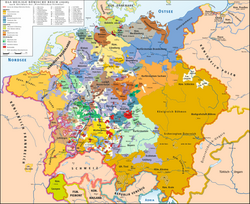
The empire in 1648, showing imperial states
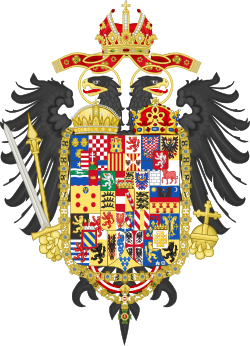
Arms of Emperor Joseph II from 1765
Formation and papal conflicts[edit]
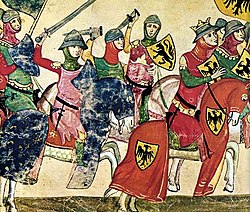
“”The Pope is ready to make some more emperors, of the Roman Empire. The Holy Roman Empire. It's actually Germany, but don't worry about it.
|
| —Bill Wurtz[19] |
For usual dynastic reasons, the Liudolfing dynasty replaced the Carolingians as the rulers of East Francia. King Otto I married the widowed Queen Adelaide of Italy, folding most of northern Italy into his German realm.[20] Since they had a good relationship, the pope crowned Otto as the first Holy Roman Emperor since Charlemagne, establishing Germany as the successor to the Western Roman Empire and ensuring that the papacy would be in charge of the succession of its rulers.
That last part was to be the problem. Since Holy Roman Emperors were elected from among a few choice members of the German nobility per Germanic tradition, the empire passed to the Salian dynasty, which didn't quite get along with the popes and had the Liudolfingers. The Salian emperors clashed with the papacy over investiture, whether the popes or royal rulers had the right to appoint bishops. Investiture was serious business since the bishops would hold church estates and the massive wealth and power that came with them. To maintain authority over church wealth, the popes wanted to ensure that only they could appoint bishops.[21]
In 1075, Pope Gregory VII composed the "Dictatus Papae", which declared that the papacy was the sole universal authority and had the legal power to remove the Holy Roman Emperor.[21] Emperor Henry IV didn't like that, and the pope retaliated by calling supporters from among the German faithful and starting a civil war in the Holy Roman Empire that lasted for decades. The bloodshed continued until 1122, when emperor Henry V signed the Concordat of Worms, effectively agreeing to leave the pope's power alone.[22] The wars, largely carried out by nobility against the emperor, permanently ensured that the empire would remain a decentralized and hollow shell.
Crusades and expansionism[edit]
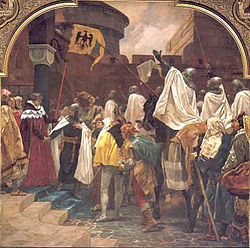
“”[We swear] to go on this journey only after avenging the blood of the crucified one by shedding Jewish blood and completely eradicating any trace of those bearing the name 'Jew'.
|
| —Godfrey of Bouillon, one of the leaders of the First Crusade[23] |
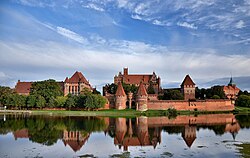
Despite that minor issue of intentionally tearing their country apart with a civil war, the Holy Roman Emperors remained loyal to Catholicism. They joined the Catholic Crusade effort to take Jerusalem and the Holy Land from the Muslims who lived there. Emperor Conrad III went forth in person during the Second Crusade, although his entire army was almost immediately destroyed in a massive flood on the way there.[24] Ouch. His successor, Frederick Barbarossa, managed to win a few battles during the Third Crusade, eventually losing against the Kurdish ruler Saladin and dying while trying to cross a river.[25] Water was the bane of German crusaders, apparently.
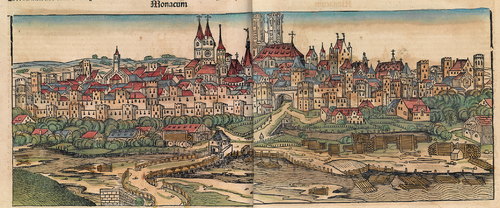
The Crusades and the general idea of Christian holy war became good ideological justifications for pushing the empire's frontiers eastwards. German princes used offers of reduced taxes and manorial obligations to encourage peasants to colonize much of what is now Pomerania, Saxony.[26] When this inevitably started conflicts, the empire overpowered the Slavic rulers with their more organized military might, bringing areas like Bohemia, Pomerania, and Silesia into the empire's fold.
German Crusaders also targeted the Baltic Coast, most significantly under the banners of the Teutonic Order. Beginning in 1233 CE, the Teutonic Order conquered Slavic pagans in Prussia, all but exterminating the native population, then built a shitload of castles to rule the region as their personal property.[27] From that point, the region of Prussia became a militarized German stronghold, which would have massive consequences later on.
While the Germans benefited from the Crusader craze, another group of people living in the empire did not. Jews, who had long been the target of antisemitism from Medieval Europeans, were targeted with pogroms by German and French Crusader wannabes who decided to wage holy war against their neighbors.[28] These events are considered the first expression of the deep European hatred towards Jews that would culminate in the Nazi genocide.[29]
Early Hapsburg era[edit]
.jpg)
The Golden Bull of 1356 made the empire's decentralized nature official, formalizing the tradition of having seven electors from the nobility choose the next emperor and granting extensive rights to local princes.[30] With the empire so broken up amongst largely autonomous local nobles, the emperor became more of a first-among-equals than anything else. It was this situation that the Hapsburg dynasty of Austria inherited. As a result of the empire's fragmentation, the Hapsburgs tended to look elsewhere to grow their power, placing relatives on the thrones of countries like Spain and Hungary.
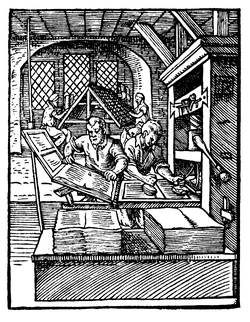
Still, the empire prospered during this time, even after the Black Death. Its location at the center of Europe ensured that its rivers and coasts hosted a vibrant international trade between northern and southern Europe and the east and the west. The wealth that this trade brought made Germany an early center for manufacturing, and its population began to urbanize and form cities along major routes. The wealthiest cities were dominated by an oligarchic merchant elite, and many of these cities grouped together in the Hanseatic League because rich assholes got to stick together.[30] The league became a serious military power, able to take down Denmark in a war, and its existence threatened the traditional dominance of landed hereditary nobility.
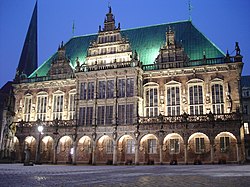
Germany's growing wealth and population also brought it into the German Renaissance, a cultural and artistic movement focused on classical knowledge that spread from Italy.[31] Principalities and cities of the empire used their wealth to undergo a construction spree, building castles and buildings all over the damn place. This was especially true of the Hanseatic Cities, which wanted to demonstrate their wealth to impress the landed nobles and gain some political status. Along with culture and art, many German thinkers started to embrace the ideals of humanism, a similar consequence of the Renaissance.
Economic and population growth was soon combined with intellectual development as well. In 1436, German goldsmith Johannes Gutenberg began designing a machine that used mobile, reusable type blocks in a printing press, allowing for the rapid production of different pages of text to produce books.[32] Until then, European texts had to be written by hand, a massive carpal tunnel syndrome-inducing pain in the wrist/ass. Of course, this being Medieval Europe, the printing press was primarily used to print Bibles and religious works but would eventually pave the way for the rapid spread of information and propaganda.
Protestant Reformation[edit]
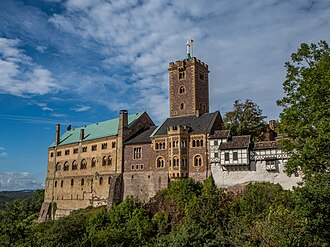
“”All of Germany is in an uproar. Nine-tenths shout out the battle cry 'Luther,' and the remaining ten percent, if they are indifferent to Luther, express the slogan 'Death to Rome.'
|
| —Aleander, papal legate, 1520[33] |

The Holy Roman Empire was a hotbed of discontent on the eve of the Reformation. The wealthy bourgeoisie in northern Germany was discontented with how little respect their riches earned, and regional princes wanted to strengthen their noble rights and further decentralize the empire.[34] Rural peasants, meanwhile, were starting to feel the effects of sustained population growth, with food becoming more expensive and wages starting to stagnate.
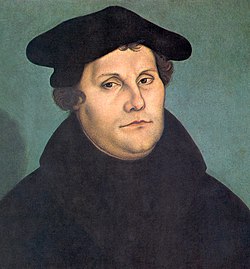
In 1517, Martin Luther, a professor of theology at Wittenberg University in Saxony, began publishing some pamphlets expressing disillusionment with the growing wealth and resulting corruption within the Catholic Church. The event which pushed him over the edge was the announcement that the Church hoped to sell a shitload of indulgences (a note that says "don't worry about that sin you just did, bro")[35] to finance the construction of St. Peter's Basilica in the Vatican City.[36] To Luther, it seemed pretty fucked up to twist theology to raise money for a kickass new building in a religion that was supposed to prize moderate living and charity. The Ninety-Five Theses, his first pamphlet on the matter, laid out a thorough critique of the practice of indulgences as corrupting both the faith of the people and the integrity of the church. This message resonated with the discontent people of northern Germany, and the printing press helped spread it all over the place. It was basically a perfect storm.
As you might expect, Church authorities told Luther to shut his fucking mouth or else be excommunicated. Luther refused to shut up and was immediately met with horrible consequences. After his excommunication, the Holy Roman Emperor declared Luther an outlaw, banned his writings, and called for either his arrest or murder.[37] However, Luther's ideas had won some support from the Holy Roman Empire's princes, especially those who wanted to use them as an excuse to push back against the emperor's authority. In a stunt worthy of a heist movie, Frederick III, the Elector of Saxony, arranged for Luther to be intercepted by agents disguised as highway robbers and secreted away to Wartburg Castle for safekeeping.[38] From his hideout there, Luther translated the New Testament into German and distributed more writings attacking the Church on matters including veneration of saints, relics, and priestly celibacy.[39] But Luther also published a shitload of antisemitism, most notably "On the Jews and their Lies", which called for the expulsion of Jews and the burning of synagogues.[40] Oh boy, what bad things could German antisemitism cause?
Lower class uprisings[edit]
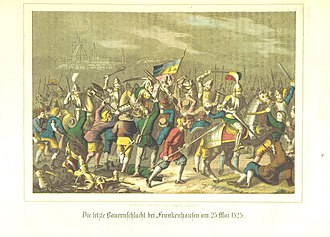
The revolutionary nature of Luther's ideas tipped the tenuous balance of German society. In 1522, the Knights' Revolt broke out, pitting impoverished lower nobles who had accepted Protestantism against the emperor and Church they resented.[41] The uprising was short and put down within a year, but it was a bad sign of violence yet to come.
In 1524, the German Peasants' War exploded. Remember those peasants who were having a hard time affording their food? Yeah, a hungry person is only a step away from becoming a rebellious person. The peasants were most angry at the Catholic Church, which Luther had exposed as corrupt and thrived by taxing local nobility, which in turn imposed heavier taxes on the peasants.[42] Peasant demands were myriad, including lower taxes, allowing congregations to choose their pastors, stopping land enclosures that cut off fish and game access, ending serfdom, and establishing a fairer justice system.[42] Pretty reasonable demands, but the nobles and Church weren't going to have any of that shit. The rebels seized the town of Heilbronn, where they formed a parliament, and Würtzburg, the seat of a Catholic bishop.[43]
Ultimately, the peasants could not overcome the military superiority of the much wealthier and more connected nobility. Luther also opposed the movement, writing that the peasants had a religious obligation to stay nice and obedient and that the nobles had every right to kill them in retribution.[42] And kill them the nobles did, massacring some 100,000 people and punishing them with even more repressive laws.[42]
Escalating religious conflicts[edit]
.jpg)
With increasing numbers of German princes and peasants joining the Protestant movement, religious conflict in Germany became inevitable. After all, when you think you have the only correct interpretation of God's word, surely everyone else must be brought to the truth by force. The various emperors during this time were furious that their imperial authority was being defied by the growing alliance of Protestant princes. To protect themselves, the Protestant nobles formed a military pact called the Schmalkaldic League, the first genuine military threat posed by the Protestants.[44] However, its members' competing personalities and goals meant that the alliance was unstable, and it was predictably smashed by the emperor in a short war in 1546.[45] The Catholics presumably thought things were over at this point, but the fact that religious tensions had caused an actual war between rulers only inflamed hatred even more. Sure enough, the Second Schmalkaldic War blew up in 1552, although the Protestants could force the emperor to negotiate with them this time.[46]
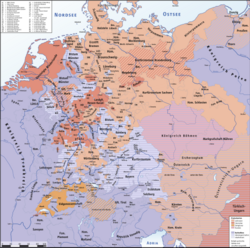
To their credit, the various rulers in Germany realized that the constant religious wars weren't going to end well for anyone. The Holy Roman Diet assembled at the command of the emperor. It proclaimed the Peace of Augsburg in 1555, allowing German princes to choose Catholicism or Lutheranism as their faith in the hopes of everyone getting the fuck along.[47] Unfortunately, people couldn't just get the fuck along.
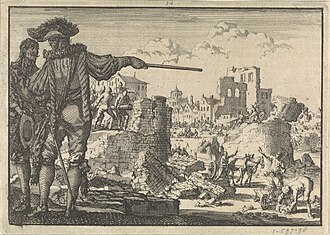
The peace almost immediately came apart when Catholic prince-bishops started converting to Protestantism. That was a major problem because they generally refused to give up their Church-given land and wealth, which was an enormous problem for the Church and faithful Catholics. When the prince-bishop of Cologne tried to do that in 1583, Catholic princes attacked him to keep Cologne in Catholic hands.[48] During the fighting, the Catholic forces surrounded the city of Neuss. They destroyed it with artillery fire, destructive house-to-house fighting, and plundering, killing an estimated 4,000 civilians.[49] Catholic forces also massacred hundreds of men, women, and children after seizing the fortress of Godesberg.[50] It also didn't help that Calvinists were explicitly left out of the peace.
In 1608, in response to further inter-religious violence, many of the Protestant powers led by the Palatinate and Brandenburg formed the Protestant Union, an even larger coalition of both Lutheran and Calvinist states, to protect against the Catholics.[51] A year later, it intervened in the War of the Jülich Succession, pitting them against both the emperor and Spain in the question of which religion's candidate would inherit the empty throne of the United Duchies of Jülich-Cleves-Berg.[52] Another bloody round of fighting later, Catholics and Protestants hated each other more than ever. Germany settled into an atmosphere of religious paranoia in which princes carefully monitored their populations for signs of religious dissent.[53] For an example of how absurd things got, German Protestants refused to accept the Gregorian calendar for decades because they were afraid that the Catholics were somehow plotting to steal time.[53] The Holy Roman Diet also couldn't get anything done because the Calvinists and Protestants liked to storm out whenever they didn't get their way, and the Catholics were morally opposed to working with them.
Thirty Years War[edit]
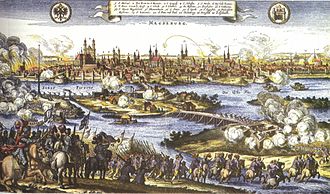
Germany's religious troubles occurred against a backdrop of general chaos in Europe. France endured the French Wars of Religion![]() against the Huguenots, decades of conflict, and mass murder which cost the lives of three million people.[54] Spain and the Netherlands duked it out over Dutch independence, a conflict aggravated by their religious differences and escalating into the total destruction of multiple cities. England was also about to fall into the English Civil War, which would draw in the rest of the British Isles.
against the Huguenots, decades of conflict, and mass murder which cost the lives of three million people.[54] Spain and the Netherlands duked it out over Dutch independence, a conflict aggravated by their religious differences and escalating into the total destruction of multiple cities. England was also about to fall into the English Civil War, which would draw in the rest of the British Isles.
_-_A_landscape_with_travellers_ambushed_outside_a_small_town.jpg)
In this atmosphere of religious crisis, Ferdinand II became the new Holy Roman Emperor and was widely known as a zealous Catholic and an oppressor of Protestants.[55] When he tried to oppress Protestants in Bohemia, a general Protestant uprising against his rule began in 1618, beginning the Thirty Years War. Although the emperor's armies smashed the initial revolt, just about every other Protestant state started jumping in. The Protestant states in northern Germany felt they had to join the revolt, but they were smashed by a Spanish army coming over from the Low Countries.[56] Denmark also tried to intervene on behalf of the Protestants, but they too fell to defeat. Emboldened by this military success, Ferdinand issued the Edict of Restitution, effectively confiscating most Protestant-held land in the empire.[57] The edict undermined the Catholic faction's victories by ensuring permanent opposition to them.
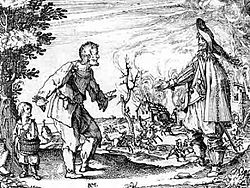
In 1630, Sweden also jumped in under its king Gustavus Adolphus, who sincerely wanted to protect the Protestants and seize some Baltic German land.[58] The Swedes and their allies were also bolstered by French funds. France, despite being a Catholic nation, hated the Hapsburg powers and hoped to undermine their power. After Gustavus' death, France joined the war directly and fought Spain and Austria for more than ten years before both sides finally agreed to a peace of exhaustion.
Throughout this fighting, the mercenary armies of the various belligerents constantly committed hideous crimes by pillaging everywhere they could and murdering anyone who resisted, regardless of which religion or which prince controlled the places they were destroying.[59][60] The armies moving back and forth resulted in vast swathes of Germany being totally razed, and the huge numbers of peasants being killed undermined Germany's ability to produce food. This caused a devastating famine, and the starving people became susceptible to numerous epidemics. The war ultimately killed five to ten million people through warfare, murder, disease, and famine.[61] Such human suffering was brought about by religious conflict.
The war lasted until 1648, when the exhausted parties finally came to the table and negotiated the Peace of Westphalia, which guaranteed limited religious freedoms for religious minorities in the empire, curbed the emperor's power even further, and allowed the various princes of the empire to choose their own state religions.[62]
Prussian ascendance[edit]
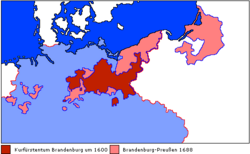
Thankfully, the Peace of Westphalia ended the empire's constant religious wars. On the other hand, the empire was dead, its central authority destroyed in the fires of war. From this point forward, the Austrian Hapsburg emperors largely neglected the empire's affairs in favor of growing the lands they held directly as the rulers of Austria.[63] Between the end of the Thirty Years' War and about 1740, the empire became a kickball to be hurled back and forth between the more centralized powers surrounding it, like France, Sweden, and the Ottoman Empire.
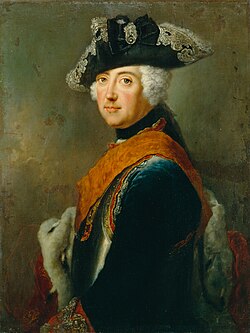
Amid this chaos, several German imperial states grew more powerful without imperial limitations. The state of Brandenburg in northern Germany, ruled by the Hohenzollern dynasty, expanded significantly by merging with the lands of the old Teutonic Order in Prussia and taking northern territories from Sweden to gain a coastline on the Baltic Sea.[64] In 1701, Brandenburg's ruler declared himself King Frederick I of Prussia. The Kingdom of Prussia benefited from a long string of competent rulers, starting when Frederick I invested much time and money in expanding the podunk little town of Berlin into a modern capital that he hoped would rival Versailles.[65] To grow its population, Prussia invited religious refugees from other parts of the empire.[66]

Frederick William I succeeded him in 1713, having spent much of his life in the military. The new king's military background completely transformed Prussia, modernizing the tax system and stripping down the government to the point where Prussia became less a country and more, like the Teutonic Order before it, a military that happened to control a patch of land.[67]
In 1740, Frederick the Great took the Prussian throne. He gained that title by starting the War of the Austrian Succession as soon as he came to power, although he did it in a pretty shitty way. 1740 was also the year that the Hapsburg Austrian crown went to a woman, Maria Theresa. This was originally super illegal under traditional German law. When Maria Theresa was born, the then-reigning emperor enacted the "Pragmatic Sanction" to ensure that she could inherit the empire.[68] This was still broadly unpopular, and various anti-Hapsburg princes of the empire and abroad considered it a nice excuse to attack Austria. Frederick the Great roped France into the effort and then invaded. Prussia hit hard and fast, stole the large and rich province of Silesia from Austria, then quit the war early to leave France holding the bag.[69] Slick. As a result, the war ended in a stalemate with Maria Theresa still mostly in control, but Prussia had grown much bigger than before.
Enlightenment absolutism[edit]
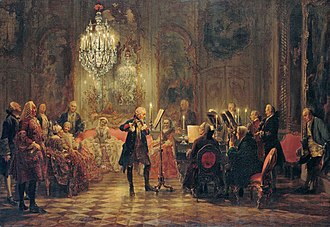
“”Let us admit the truth: the arts and philosophy extend to only the few; the vast mass, the common peoples and the bulk of nobility, remain what nature has made them, that is to say savage beasts.
|
| —Frederick the Great to Voltaire.[70] |
Frederick and his nemesis Maria Theresa might have hated each other's guts, but they did have many ideas in common. Both embraced many ideas of the Enlightenment, a continental intellectual movement aimed at promoting reason, secularism, and science that gained much influence in the late eighteenth century. However, both rulers were also determined to use these ideas to bolster their own power rather than give any more say to the people. They both essentially believed themselves to be benevolent dictators.
Both Prussia and Austria reformed their administrations to make them as efficient as possible, and both Prussia and Austria strove to extend religious tolerance as much as possible in the era to attract migration and keep society harmonious.[71] Frederick became a close friend of French philosophe Voltaire and was generally enamored with French intellectual life.[70] On top of this, he allowed for the freedom of the press, encouraged the arts, and favored scientific and philosophical endeavors. Maria Theresa and her son Joseph II modernized the state by dramatically reducing the power of the Catholic Church over secular affairs and abolishing many of the old harsh punishments for crimes.[70]
Many of Germany's smaller states followed their example in the Enlightenment or went even further, such as the almost-democratic government adopted by Württemberg.[72] As a result, Germany was fairly well governed during this era despite the lack of democracy. All rulers hoped to avoid the religious chaos of the old ways. When the Catholic ecclesiastical state of Salzburg decided to expel Protestants in 1731, most German rulers, regardless of religion, were disgusted.[72] With the German states recovering from the religious wars, there was another great building spree following the Baroque tradition by German rulers wanting to demonstrate their expanded wealth and power.[73]
Palace of Potsdam.
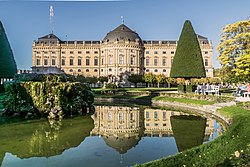
Würzburg Palace.
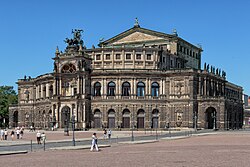
Opera House of Dresden, Saxony.
Sanssouci palace and gardens, summer residence of Frederick the Great.
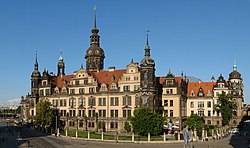
Dresden Castle.
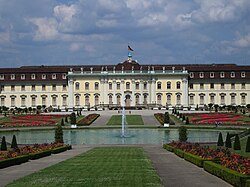
Ludwigsburg Palace, the "Versailles of Swabia".
All of that being said, probably the greatest expression of rising German power during this period was the repeated partitions of Poland. In 1772, 1793, and 1795 Prussia, Austria, and Russia set aside their differences to gleefully seize Polish territory until there was nothing left.[74] Poor Poland, previously a major power, realized the consequences of being wedged between an increasingly powerful Germany and Russia.
French Revolution and Napoleon[edit]
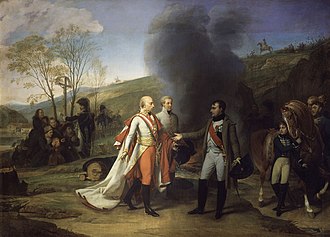
Meanwhile, in France, the Enlightenment combined with longstanding societal resentment towards the king to create the French Revolution in 1789, in which the French people forcefully created first a constitutional monarchy and then an outright republic. The Enlightenment had been powerful in Germany, so the initial stages of the French Revolution were well-received by German intellectuals and the educated class.[75] However, things took a turn sharply for the worse when the Jacobins took over and created the First French Republic since they imprisoned France's queen Marie Antoinette. Marie Antoinette just so happened to be the Holy Roman Emperor's sister.[76] Oh shit.
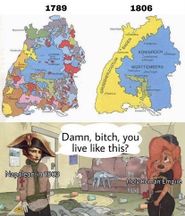
In a rare show of unity, Frederick William II of Prussia and Habsburg Holy Roman Emperor Leopold II issued the Declaration of Pillnitz in 1791 to support the French monarchy.[77] The French revolutionary government interpreted that as a threat and preemptively declared war on both parties, beginning the War of the First Coalition when the rest of the Holy Roman Empire rallied to defend the conservative order. In the hopes of threatening the revolutionary government into submission, Prussia and Austria promised to raze Paris and slaughter its inhabitants if anything bad happened to the king or Marie Antoinette.[78] The problem was that this promise came right after the royal family was guillotined, and the fear that the threat caused helped motivate the French armies into victory over the empire.
France also benefited from the leadership of Napoleon Bonaparte, the brilliant general who seized power in France in a 1799 coup. When Napoleon declared himself emperor in 1801, Austria wouldn't stand for it since they were supposed to be the leaders of the Holy Roman Empire, which was supposed to be Europe's only Catholic empire.[79] Sometimes you just wanna feel special. These tensions over titles contributed to Austria's entry into the War of the Third Coalition in 1805. Unfortunately for Leopold, Prussia chose to remain neutral, meaning that much of the empire's military strength was sidelined.[80]
Austria and its remaining German allies got smashed easily by Napoleon, culminating in the Battle of Austerlitz, in which Napoleon defeated a much larger joint German-Russian force.[81] With the empire totally defeated, Napoleon decided to mercifully put the ill-begotten entity out of its misery. In the Peace of Pressburg, he reorganized it into a series of Napoleonic puppet states, grouping them into the "Confederation of the Rhine".[82] It also just so happened that Germany's internal borders looked much nicer. The Confederation of the Rhine then jointly seceded from the Holy Roman Empire, leaving it a hollow shell.[83] With Prussia not interested in preserving the empire either, Austrian emperor Francis II finally acknowledged reality and gave up on it.
German disunity[edit]
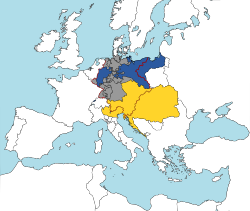
Post-Napoleonic order[edit]
Although Napoleon eventually met his downfall in 1815, his conquests left a broad legacy of change. He had improved public administration, greatly weakened the institutions of feudalism and trade guilds, and largely abolished ecclesiastical territories.[84] He had also broken the hopeless tangle of imperial disunity, reducing Germany from 300 states to a much more manageable 40. Germany had been dragged kicking and screaming into something resembling modernity.
These changes were largely maintained by the Congress of Vienna, a continental peace conference assembled to figure out what the fuck to do after the European order had been so thoroughly shattered by Napoleon[85] (it should be noted that in German, this had the amusing name of Wiener Congress). The primary agenda was to figure out how to restore the conservative tradition of monarchies.
Rather than reestablish the HRE, which would have been a colossal pain in the ass, the delegates at Vienna decided that Germany would be grouped into an entity called the German Confederation. The states within it would technically be sovereign, but the confederal government (which would always be led by an Austrian) would have some say in their internal affairs. Austrian statesman Klemens von Metternich promptly used the Confederation to suppress any further revolutionary threat by imposing censorship regulations and keeping a close eye on German universities.[86] This did much to suppress German intellectual and cultural life.
Although not the leader of the Confederation, Prussia benefited greatly from the Congress of Vienna and its new European order. In exchange for handing some relatively low-population Polish territories to Russia, Prussia gained the Rhineland and Westphalia, densely-populated regions rich in natural resources like coal and iron.[87] These parts of Germany quickly became at the forefront of the Industrial Revolution in continental Europe, thus turning Prussia into a European superpower.
Rising nationalism[edit]
“”The first, original, and truly natural boundaries of states are beyond doubt their internal boundaries. Those who speak the same language are joined to each other by a multitude of invisible bonds by nature herself, long before any human art begins; they understand each other and have the power of continuing to make themselves understood more and more clearly; they belong together and are by nature one and an inseparable whole.
|
| —Johann Gottlieb Fichte, To the German Nation, 1806.[88] |
Alongside Napoleon's administrative and civil reforms, there was also a much greater societal push toward nationalism, specifically focused on German unification. Napoleon's easy victories over the disunited Holy Roman Empire convinced many Germans of the need for strength through unity. In northern Germany, nationalism gained a religious component, with intellectuals claiming Martin Luther as the first German nationalist and festivals being held burning works by Austrian Catholics as reactionary bunk.[89] (Germans do like their book-burnings). Nationalism also gained traction with wealthy business owners, who spent the 1820s pushing for a customs union in the Confederation and hoped that an economically integrated Germany could match the industrial might of the United Kingdom.[90] On the other hand, poor farmers were generally left out of discussions, as they were considered too stupid.
Revolutions of 1848[edit]

Rising nationalist sentiment hit a boiling point in 1846 when the European potato crop failed, causing food prices to skyrocket and causing the economy to do the opposite.[91] As tends to happen, hungry people became the breeding ground for revolution. In 1848, an uprising among the famously restless French forced French king Louis Philippe I to abdicate and flee to the UK. The success there inspired similar movements in Germany.
Revolts broke out in Vienna and Berlin, initially with little organization or goal. However, they eventually solidified around the goal of German unification when liberal activists created the Frankfurt Assembly in Frankfurt am Main to create a nationally-elected parliament.[92] In 1849, the assembly produced a democratic constitution and offered to help crown King Frederick William IV of Prussia as the emperor of a united Germany. Unfortunately, the king was far too conservative to accept a crown from anyone save the noble princes of Germany.
The Prussian king instead created his own constitution based on the principle of absolute monarchy, and he used military force to roll back the revolutionary tide and shut down the Frankfurt Assembly.[93]
Socialism and industry[edit]
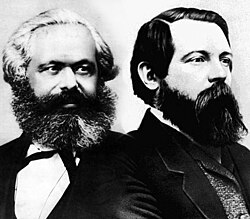
Remember how Prussia got the Rhineland, a region they then started exploiting for industry? Well, in 1818, a certain Karl Marx was born there, in the city of Trier. His upbringing in an industrial area, combined with the experience of having one of his liberal mentors subjected to surveillance and arrest, caused him to embrace the ideals of socialism and then communism.[94] Marx eventually went into exile, living in Paris and then Brussels, Belgium. In Brussels, he studied history and outlined what came to be known as the materialist conception of history. He then met close collaborator Friedrich Engels, formed an organization to link socialist-minded thinkers around Europe, and helped found the Communist League in London.[94] The League then asked Marx to write its manifesto, which he wrote and published with Engels in 1848 as the Communist Manifesto.
Engels, meanwhile, took part in the 1848 uprisings and was exiled to Switzerland for his trouble.[95] After Marx died, Engels helped edit Das Kapital, and he became a leading figure in international socialism. Engels helped preserve the socialist movement in Germany during the post-revolutionary period, where conservative rulers cracked down on political dissent. Marxist thought remained relevant in large part due to Germany's rapid industrialization and deteriorating social conditions that came with it.
The German Question[edit]
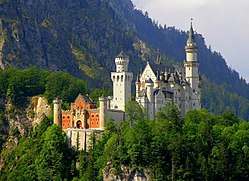
The Revolution of 1848 also brought about the German Question, as the Frankfurt Assembly had toyed with the idea of having Austria's ruler unite Germany instead. Supporters of the Großdeutsche Lösung ("Greater German solution") favored unifying all German peoples, while supporters of the Kleindeutsche Lösung ("Little German solution") believed instead that German unification should exclude Austria entirely.[96] The latter option was favored by Prussia, who wanted to dominate any potential German state and viewed excluding Austria as the easiest way to ensure that would happen.[97] The German Question would shape the entire effort to unite Germany.
German unification[edit]
“”There is, in political geography, no Germany proper to speak of. There are Kingdoms and Grand Duchies, and Duchies and Principalities, inhabited by Germans, and each separately ruled by an independent sovereign with all the machinery of State. Yet there is a natural undercurrent tending to a national feeling and toward a union of the Germans into one great nation, ruled by one common head as a national unit.
|
| —The New York Times, July 1, 1866[98] |
Bringing in Bismarck[edit]
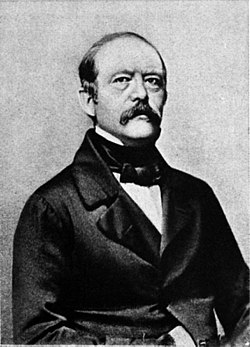
“”The great questions of the time will not be resolved by speeches and majority decisions – that was the great mistake of 1848 and 1849 – but by iron and blood.
|
| —Otto von Bismarck, speech to the Budget Committee of the Prussian Chamber of Deputies, 1862.[99] |
After the 1848 revolution, the Prussian public became far more in favor of the concept of a Prussian-led German unification. In 1862, the process began when King Wilhelm I of Prussia chose the relatively obscure nationalist diplomat Otto von Bismarck to lead the government. A staunch Protestant conservative, Bismarck hated the ideals of democracy, socialism, and Catholicism.[100] That being said, Bismarck was wise enough to realize that at least some of those popular concepts needed to be mobilized on his side if his dream of a powerful Germany would become a reality. Luckily for him, the hated state of Austria would prove to be a useful target to unite the German states against.
German unification was going to be a formidable task. The princes of the small German states quite liked being independent. Some of them, like Bavaria in the south, were fairly powerful in their own right. Bavaria also presented the problem of having the vast majority of its population follow the Catholic faith, which made it and the other southern German states reluctant to follow the leadership of the Protestant north. Not surprising given the, uh, history between them.
Beating up Denmark[edit]
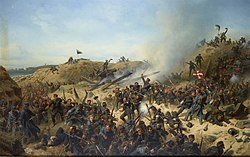
In 1864, poor little Denmark became the first victim of Bismarck's aspirations after the King of Denmark's death sparked dispute over the succession.[101] Denmark had expanded south along the Jutland peninsula and gained control of two small German states, Schleswig and Holstein.[102] They had been assigned to Denmark by the British (who stuck their grubby noses into everything), but in an awkward manner that kept them mostly autonomous. When Denmark tried to tie them closer, Prussia and Austria both objected and jumped into a war on the claim that Denmark had violated the agreement and planned to begin oppressing the German minority population.[102]
As you might expect, Denmark didn't stand much of a chance. The real issue arose when Prussia and Austria sat down to decide who would get the spoils. Schleswig and Holstein happened to sit at a geographically important spot since a canal could be cut through the peninsula at the city of Kiel to bypass Denmark and link the Baltic to the Atlantic.[103] Austria and Prussia eventually agreed to take one state each. The question of resolving the Danish war raised the much broader question of which power would become the master of Germany.[104] Unable to talk it out, Austria and Prussia decided to have their final showdown.
The brother's war[edit]
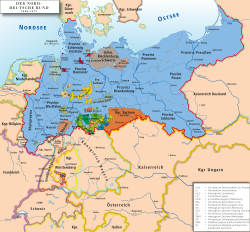
This is where Austria's vast empire fucked them a little since Prussia managed to rope Italy into attacking Austria simultaneously to regain the Italian land that Austria had held for the last few decades.[105] Prussia began its war against Austria at the same time, in 1866, facing a pretty powerful alliance of Austria along with Bavaria, Saxony, Hanover, Württemberg, Hesse, and Baden.[106] The Austrian alliance had Prussia badly outnumbered.
Bismarck's diplomacy, however, won the day. By getting Italy into the fray, he could divert much of Austria's resources southwards, leaving Prussia free to deal with Austria's smaller allies.[107] Prussia's superior military, backed by industrial war production and rigid discipline, could overwhelm the divided allies. Prussia then invaded Austria, conducting a rapid campaign through Bohemia and winning a short series of victories over a handful of weeks to force Austria to the negotiating table.[108]
Bismarck kept his demands relatively light, excluding Austria from German affairs, taking control of Schleswig-Holstein, and folding all northern Germany into Prussia's sphere of influence.[109] Austrian ruler Franz Joseph was apparently not too upset by that, being totally disgusted with the shoddy performance of his German allies.[109] He said little when Prussia annexed its north German neighbors to become the North German Confederation. This dramatically boosted Prussian power and brought it one step closer to unification. Some states were annexed directly into Prussia, but others, like Saxony, were preserved as semi-autonomous units of the Confederation.
Beating up France[edit]
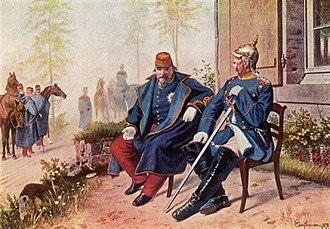
With all that accomplished, though, Bismarck had only finished the easy part. The hard part would be to get the stubborn Catholic southerners to willingly join Germany as well, as their cultural and religious differences were still significant.[110]
Bismarck's solution was to unite them with Prussia against a common foe. France proved to be a uniquely advantageous candidate, ruled by the impulsive and ill-tempered Emperor Napoleon III and already on unfriendly terms with most of the German states. In 1870, Bismarck decided to engineer a war by editing and leaking an internal message from the Prussian king, making it seem like he had insulted a French diplomat.[111] He (correctly) believed it would incite the French "like a red rag to a bull".[112] The edited telegram had exactly the result intended, as fiercely nationalist French crowds gathered in Paris to demand a war of honor against Prussia. Napoleon III was also assured by his advisers that the war would be quick and bolster his popularity with the French people.[113]
France thus declared war on Prussia over a diplomatic slight, thus casting France as the big meanie and Prussia as the put-upon defender forced into an unwanted war. Poor Prussia! With France launching a reckless attack on a German state, the southern Germans did as Bismarck hoped and rallied to support Prussia.
What followed was an unmitigated disaster for France, as while the war had been reckless on their part, it had been coldly calculated by Bismarck. Prussia used railroads and efficient organization to deliver 380,000 troops to the front lines in just over two weeks, while the French troops reached the front much later and were poorly equipped.[113] They completely overwhelmed the inferior French military and thoroughly defeated it in just two months. At the Battle of Sedan, France suffered a devastating loss, and Napoleon III was actually captured by the Prussian army.[114] The Germans then occupied much of northern France and laid siege to Paris, blowing a lot of shit up with their artillery.
The Second Reich[edit]
“”There is only one person who is master in this Empire and I am not going to tolerate any other.
|
| —Wilhelm II, 1891.[115] |
-de.svg.png)
The German Empire with constituent states.
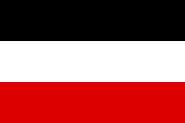
The German imperial flag.
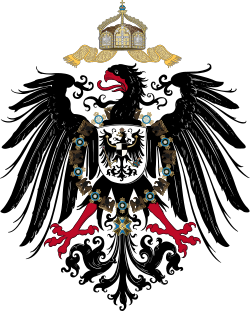
German imperial arms.
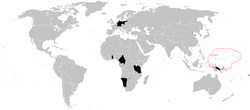
German colonial empire at its height in 1914.
.svg.png)
German naval war ensign.
Three hurrahs for Germany![edit]
.jpg)
“”It's hard to be emperor under such a chancellor.
|
| —Wilhelm I, German Emperor, about Bismarck.[116] |
After Paris surrendered in the Franco-Prussian War, the final step in Bismarck's plan became a reality. Prussian troops paraded through Paris to rub salt in the wound while partaking in one of Germany's favorite activities. Prussian King Wilhelm I arrived at the Palace of Versailles, where the various German princes waited for him. Having hashed things out through 1870, the princes all participated in an 1871 ceremony in the Hall of Mirrors where they recognized Wilhelm I as the first Emperor of the German Empire.[117]
The empire became an aristocratic federation, with German princely states represented by an upper parliamentary house called the Bundesrat.[118] An elected Reichstag served as the lower house, representing the commoners with universal male suffrage and elections every five years.[119] Unfortunately, the Reichstag had little real power, lacking the right to draft legislation, dismiss the chancellor, or act as a check on the government's actions.[120] On the other hand, the emperor appointed the chancellor to lead the government, and he had the power to threaten the Reichstag into compliance because he had the right to call for snap elections. Bismarck was, as you would expect, the first appointed chancellor.
Social developments[edit]
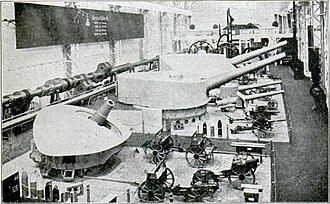
Bismarck became the champion of conservatism within the German Empire, and he championed universal male suffrage out of a belief that the rural poor would reliably vote conservative.[121] That didn't happen. Instead, the poor voted more in line with their interests, favoring either the Center Party (which supported Catholic issues) or the social democrats. Bismarck angrily denounced them as "Reichsfeinde" or "enemies of the empire".[121] This was probably most directed at the Catholics since, as mentioned, Bismarck didn't trust the loyalty of Catholic Germans. His suspicions were seemingly confirmed when The Vatican declared in 1870 the doctrine of "papal infallibility", which he feared would make the Catholics even more likely to be loyal to the pope before the emperor.
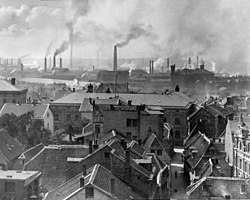
Thus began the Kulturkampf, a political clash between Bismarck, his liberal allies of convenience, and the church.[122] Bismarck forbade priests from preaching politics at the pulpit in 1871; in 1872, he made all religious schools subject to state inspection.[122] To Americans, this just sounds like a basic separation of church and state, but these policies were strongly resisted by Germany's Catholics. Bismarck redoubled his efforts, dissolving the Jesuit order, severing diplomatic relations with the Vatican, and making the Church's ecclesiastical appointments subject to state authority.[122]
Although some major policies came out of it, the culture war completely backfired when the Center Party just kept winning more seats in the Reichstag. After tiring of the enterprise, Bismarck broke off his alliance with the liberals and instead focused his efforts on trying to limit the appeal of socialism. As before, the heavy-handed approach didn't work, as Bismarck discovered when he banned socialism from the press in 1874 and then more desperately banned social democracy and socialism outright.[123]
When that didn't stop socialists from winning seats as independent candidates, Bismarck focused on co-opting the socialist platform, hoping to bribe workers away from them. In 1883, Bismarck forced the Health Insurance Law, which created the first national healthcare system in the world.[124] Employers and employees paid into insurance funds, and the German government verified workers' enrollment by comparing employer records with fund membership lists, threatening employers of uninsured workers with fines. Bismarck followed that up with an accident insurance law in 1884. In 1889, Germany became the first country to implement an old-age social insurance program, which even the United States Social Security Administration acknowledges as one of its primary models.[125] Still, most socialists and social democrats recognized the ruse as a ruse.
Colonialism[edit]
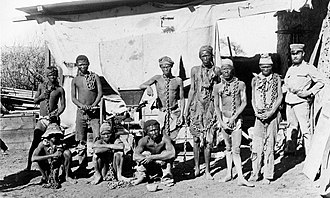
Germany came late to colonialism due to, y'know, not existing before 1871. However, it was still a major power, and there was still time to edge it into the game. Germany's status was confirmed when Bismarck got to host the Berlin Conference in 1884 to ensure that the intense competition over African land wouldn't cause a European war that Germany would get sucked into. In Berlin, diplomats from the major colonial powers arrived to hash out who would get what chunks of Africa.[126][127] They effectively drew lines on a map.
Still, most of the best chunks of Africa, like Egypt, Nigeria, or the Congo, were taken already. Some regions they did get, like Cameroon and Togo, became giant plantations where Africans were forced to labor under deadly harsh conditions.[128] The German Empire also tried to eliminate local languages by banning them from schools and ordering that all official business be conducted in the German language.[129]
In German Southwest Africa, known today as Namibia, the Germans outright committed genocide against the Herero and Namaqua tribes for the crime of rising up to protest the Germans' use of all of the arid region's scarce water supply.[130] German colonial troops drove the tribes out of their homes and into the unsurvivable Namibian desert before confining them to concentration camps, where the survivors were either worked or beaten to death.[131] It is estimated that this led to the extermination of about 80% of the Herero and Nama populations.[132] In terms of hard numbers, that adds up to roughly 100,000 people murdered.[133] Seizing the opportunity, German scientist Eugen Fischer set up shop in the concentration camps to conduct evil medical experiments on the helpless prisoners.[133] Remind you of anything?
Enmity with France (and nearly everybody else)[edit]
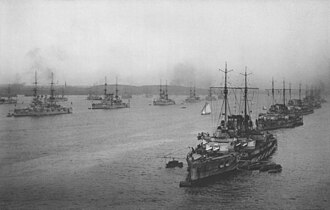
“”That young man wants war with Russia, and would like to draw his sword straight away if he could. I shall not be a party to it.
|
| —Bismarck comments on Wilhelm II's foreign policy ideas.[134] |
Bismarck had recognized that Germany's position in the world was precarious due to its central location in Europe. France, for instance, would be an implacable enemy forever because of the humiliation they suffered in 1870 and the empire's annexation of the formerly French border region of Alsace-Lorraine.[135] France wanted that shit back, really bad. As a result, Bismarck's foreign policy focused on appeasing everyone and ensuring that the various powers of Europe were more friendly to Germany than they were to France.[136]
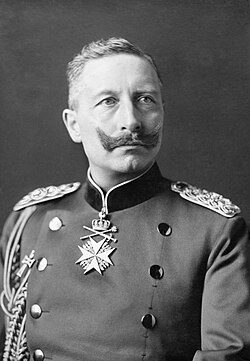
Then the old emperor died in 1888, followed just 3 months later by his son Friedrich III's death from cancer, and the throne went to his grandson Wilhelm II. Initially this was a relief to Bismarck, because Friedrich III had been a vehement liberal who wanted to establish a British-style constitutional monarchy. But Kaiser Wilhelm II, perpetually jealous of his cousins who reigned in other European monarchies, wanted to chart an aggressive and "glorious" path, and he quickly fired Bismarck when the old chancellor objected. His toxic and abrasive personality clashed with his cousin Tsar Nicholas II of Russia, and Wilhelm then impulsively decided to terminate the non-aggression treaty between them in 1890.[137] With Russia and France in the "fuck Germany" camp, the two powers signed an alliance in 1894.[138] Bismarck's worst fear of Germany being sandwiched between two enemies had been realized.
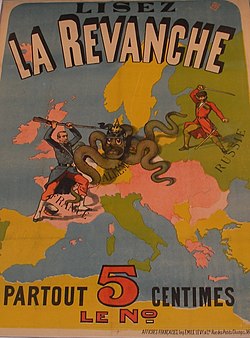
Wilhelm then ordered a vast expansion of the imperial German navy, explicitly stating that his intention was to compete with the British. In typically impulsive Wilhelm II fashion, this wasn't because Germany stood to gain from it but because he was jealous of his other cousin King George V's powerful navy. As you might expect, the British weren't a fan of this idea, and the two powers thus entered into an increasingly bitter naval arms race.[139] And just to make things even more dangerous, Wilhelm kicked off the Morocco Crises by interfering with French influence in the area in 1904, beginning a diplomatic fiasco that increased France's hatred and made the British even warier of Germany.[140] In the same year, France and the UK signed the "Entente Cordiale", promising to support each other's colonial ventures against Germany.[141] In other words, Wilhelm II was such an asshole that he managed to reverse about a thousand years of constant Anglo-French hostility.
Germany did, however, have a scarce few friends left in Europe. Bismarck had managed to repair relations with Austria and forge an alliance with them, an initiative that Wilhelm had not managed to screw up.[142] Wilhelm, for his part, had drawn closer to the Ottoman Empire, expanding political and economic ties by funding the Berlin–Baghdad railway to help integrate the Ottoman Empire and help Germany reach its eastern colonies.[143] The two powers were not quite allied, but they weren't acting all pissy with each other as Germany had been with almost everybody else.
World War I[edit]
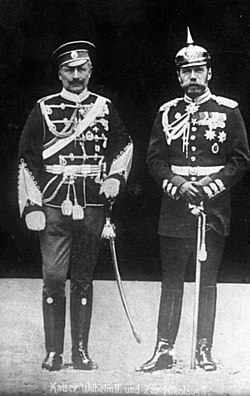
Outbreak and deceit[edit]
“”To try and avoid such a calamity as a European war I beg you in the name of our old friendship to do what you can to stop your allies from going too far.
|
| —Tsar Nicholas II telegram to Wilhelm II on the eve of the war.[144] |
“”Thanks for your telegram. I yesterday pointed out to your government the way by which alone war may be avoided. Although I requested an answer for noon today, no telegram from my ambassador conveying an answer from your Government has reached me as yet. I therefore have been obliged to mobilize my army.
|
| —Wilhelm II to the Tsar, several hours before declaring war.[144] |
Wilhelm and Germany fucked things even harder in the crisis leading up to the Great War. After the infamous assassination of Austrian Archduke Franz Ferdinand in 1914, a diplomatic scramble-fest ensued among various European powers in the hopes of avoiding war. Although much has been made of the fact that Austria was the first to open the festivities, Germany was far from blameless in helping to begin the bloodbath. Despite knowing that all of Austria's actions were posturing in the hopes of manufacturing a further reason to attack Serbia over the assassination, Germany repeatedly assured the rest of Europe that it had things under control and that Austria wouldn't do anything rashly.[145] All of this bullshit was meant to give Austria cover in the hopes that if the war began unexpectedly, the allies would lack the resolve to immediately jump in.
The plan did not fall into place. Austria declared war on Serbia on the 28th of July, and when Germany immediately backed them, it became apparent that the Germans' talk of trying to keep the peace and restrain its ally had all been lies. The other powers of Europe, especially Russia, were pissed. The German ambassador to Russia recounted that the Russian Foreign Minister "now saw through our whole deceitful policy, he no longer doubted that we had known the Austro-Hungarian plans and that it was all a well-laid scheme between us and the Vienna Cabinet."[146]
The dominoes quickly fell into place after that, as each great power honored their alliances and joined the war. Germany found itself in the unenviable position of fighting a resentful Russia on one side and hated France on the other. The conflict also spread to Asia and Africa. Germanys primary Asian ally was the Ottoman Empire, whilst its primary African allies were Sultan Diiriye Guure's kingdom headquartered in Taleh, Abyssinian emperor Lij Iyasu, and the Darfur Sultanate. The Dervish Garadate of Diiriye Guure was the last of these to be defeated in 1920.[147]
Bloodbath[edit]
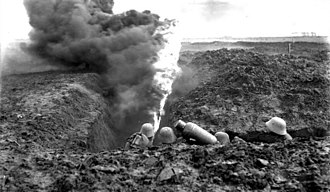
German leaders realized that being caught between two powers was a bad place to be. Their plan to avoid this had been proposed in 1905 by Alfred von Schlieffen, chief of the German general staff.[148] The Schlieffen Plan called for a rapid and overwhelming attack to defeat France while token forces held the line against Russia. Once France was out of the picture, the Germans could turn east. Instead of invading the German-French border, the Germans would advance through Belgium and turn south to catch France by surprise and capture Paris, forcing them to make peace.[149]
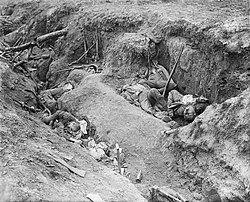
Although Belgium fell and German armies advanced through northern France, the promised knockout blow never materialized. Instead, France halted the German advance before they reached Paris in the First Battle of the Marne.[150] Both sides attempted to outflank each other before reaching the sea,[151] an unsuccessful maneuvering fest that left everybody staring at each other over a line of fortifications. You know where this is going. The advent of the machine gun and modern artillery meant that attacking an enemy formation with conventional 19th-century tactics (like everybody had been doing) was tantamount to suicide. Soldiers dug into the ground for safety against each other's deadly firepower, rapidly developing into the infamous trench warfare system.[152] By October 1914, none of the armies could make any meaningful advances, and by the end of the year, about 475 miles of trenches had been built across the entire length of the Western Front.[153]
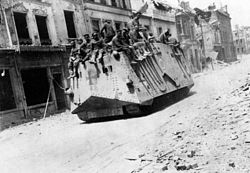
Invading Belgium also gave Britain (by treaty the guarantor of Belgian neutrality) a sufficient excuse to rally the already anti-German populace to support war. From late 1914 onwards, the British Royal Navy blockaded the English Channel and the North Sea entrances, hoping to starve Germany and Austria into submission.[154] The impacts on the Central Powers were immediate, and civilians started to suffer food shortages as early as 1916. Both sides used submarines against merchant shipping, as submarines were undetectable but too fragile to compete with surface warships.[155] British shipping defended itself by flying the flags of neutral countries, which caused Germany to declare its policy of allowing its submarines to sink neutral shipping. Foreign reaction to unrestricted German warfare was very negative, especially after the Germans sank the RMS Lusitania, (which seemed to be) a passenger ship.[156]
Meanwhile, Germany steamrolled the Russians, causing horrific suffering and an enormous refugee crisis. German scientists also introduced chemical weapons in the form of poison gas, further increasing the suffering of trench warfare. Germany's African colonies were quickly overrun by France and the UK. The British blockade of Germany's ports, which Germany's great navy had been unable to breach, made matters much worse. The winter of 1916-1917 was horrific; German civilians called it the "Turnip Winter" as the potato crop had failed, and they were forced to eat rutabagas instead.[157] The entry of the United States into the war, brought about by anger against the German submarine campaign, made victory seem impossible. Starvation and hopelessness combined with the deaths of 2,037,000 German soldiers created a demographic, political, and humanitarian emergency for Germany.[158]
German Revolution[edit]
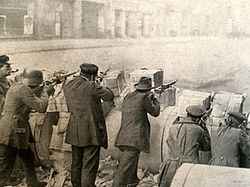
Things came to a head in 1918 when sailors in Kiel refused to take part in a planned final strike.[159] When the mutineers were arrested, this spiraled into a massive protest involving sailors and civilians. Protests quickly spread across the country. By November, the revolutionaries had bagged themselves a monarch, forcing the king of Bavaria to flee Germany and proclaiming a "People's State" in his absence.[160] On the 9th of November, the new German Chancellor Max von Baden announced the Kaiser's abdication, entirely to the Kaiser's surprise.[161] On the advice of Paul von Hindenburg, however, the Kaiser accepted that the loss of his crown was inevitable, and he left for exile in the Netherlands.[161]
After the armistice, Max von Baden found himself unable to negotiate a lasting peace. He resigned and illegally handed the reins to Friedrich Ebert.[161] Ebert's colleague from the German Social Democratic Party, Philipp Scheidemann, went behind his back to declare Germany a republic.
Meanwhile, the more radical elements of the Social Democratic Party created the "Spartacus League", led by Karl Liebknecht and Rosa Luxembourg. This kicked off about a year of communist uprisings in Germany, featuring warfare between the Spartacists and the Freikorps of right-wing war veterans assembled by the government in response.[162] The Freikorps, battle-hardened and armed with modern rifles and machine guns, were ruthlessly effective and merciless in putting down the uprising and summarily executing Luxembourg and Liebknecht.
Treaty of Versailles[edit]
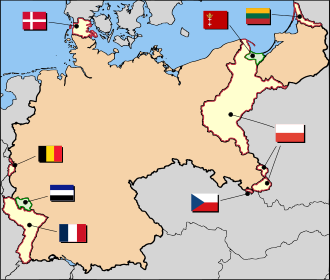
After the Kaiser was gone, the German diplomatic corps simply agreed to whatever terms the allies wanted for an armistice.[163] The Germans, now with a new government and the old warmongers tossed out, expected peace would be relatively lenient for them, probably taking place within the framework of Woodrow Wilson's "Fourteen Points" plan. The other European powers promptly tossed out Wilson's plan and proceeded with harsh terms against Germany, as most of the Entente not only demanded compensation from Germany for their wartime suffering but had also made secret treaties with other countries about how Germany would be split up.[164]
The Germans were shocked by the treaty's terms, as they had been assured a relatively soft peace in return for the truce.[164] Germany was forced to cede Alsace-Lorraine back to France, allow the Saarland to be placed under military occupation, cede some areas to Belgium, cede northern Schleswig to Denmark, cede parts of Silesia and West Prussia to the resurrected Poland, and lose its colonial holdings to France, the UK, and Japan.[164] Germany was then forced to demilitarize. A "war guilt" clause also declared Germany the primary aggressor in the war and made them responsible for paying reparations to the Entente powers. This last part caused much anger among the Germans, although the Entente powers subsequently agreed to lessen and indefinitely postpone the payments.[165]
In the end, the treaty was neither lenient nor harsh enough to prevent another war. Germany was not pacified by a light-handed peace nor weakened enough by the territorial losses inflicted upon it. The Entente powers themselves realized that the agreement had problems. British representative John Maynard Keynes predicted that the treaty's reparations clause would inflame German revanchism, while French Marshal Ferdinand Foch criticized the treaty for treating Germany too leniently.[165]
Weimar Republic[edit]
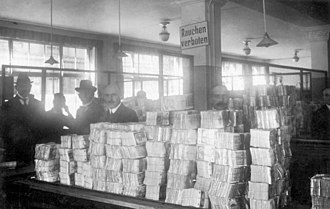
“”Now we have a Republic, the problem is we have no Republicans.
|
| —Walter Rathenau, first Foreign Minister of the Weimar Republic.[166] |
Interwar misery[edit]
Born out of revolution and wartime carnage, the Weimar Republic was perpetually unstable from the beginning. The republic gets its name because its constitution had to be adopted in the city of Weimar rather than Berlin, as Berlin was occupied by the Spartacists at the time.[167] Alongside the communist uprisings, conservatives attempted to overthrow the government in 1919 in the hopes of re-establishing the monarchy and reversing the revolution.[168]
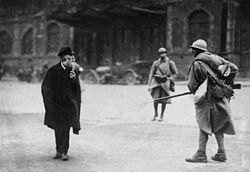
The new republic's constitution had a powerful president, seen by many as a substitute Kaiser. The president was elected by popular direct ballot to a seven-year term and could be reelected. He appointed the chancellor and cabinet ministers, and could dissolve the Reichstag and govern without its consent.[169] You should remember that last bit since it would cause some major problems down the road.
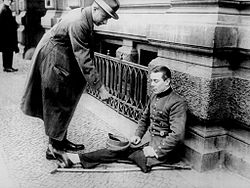
Compounding the republic's political instability was the problem of hyperinflation, which plagued Germany due to the government's short-sighted policy of printing money to make reparations payments.[170] Even then, Germany had issues meeting the requirements, so France sent angry troops to occupy Germany's industrial Rhineland to take control of the factories and confiscate goods.[171] German passive resistance to this was met with gunfire and expulsions. Hyperinflation caused a total collapse in Germany's currency, to the point where by 1923, the US dollar was worth an absurd 4,210,500,000,000 German marks.[172]
Germany's reconstruction began under chancellor Gustav Stresemann, who was the architect of its foreign policy for much of the early republic. Stresemann successfully negotiated reduced reparations payments and managed to get the French occupation forces withdrawn from the Rhineland by promising to keep the region demilitarized.[173] This was some truly skilled statesmanship, but it pissed off the rightists who thought that Germany should take everything by force because the world owed it. To them, the republic's diplomacy, as well as its very existence, was an unacceptable betrayal of everything it was to be German.
A sabotaged democracy[edit]
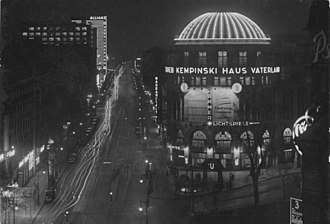
The republic quickly became a failed government, with most of the population having no faith in it. The far-left, for instance, regarded the republic as a tool of the moneyed bourgeois to keep the poor under control, bitterly remembering the republic's role in putting down the Spartacist uprising.[174] The left, however, was too disorganized and weak to pose a real threat to the republic.
No, the real threat came from the right, who hated the republic's democratic principles and longed for a return to the old conservatism and comfort of an absolute monarchy. Or, failing that, an absolute dictatorship. The right was so dangerous because it enjoyed the support of most of Germany's establishment: the military, the financial elites, the state bureaucracy, the educational system, and much of the press.[174] Right-wing parties in the Reichstag openly hoped to dismantle democracy and place Germany back on a path of militarism. Political violence and assassinations were prevalent, mainly acts perpetrated by the far-right.[175] Right-wing parties managed to influence judicial appointments and said judges would promptly let right-wing terrorists off with negligible sentences while harshly punishing leftists.[174]
On the other hand, the republic did allow a brief flourishing of German cultural life. After the chaos of the postwar period settled down, Germany had its own modest version of the "Roaring Twenties." Social liberals in the big cities could live freely, with sexual liberation movements, homosexual establishments, and a thriving nightlife being notable.[176] The Institut für Sexualwissenschaft, run by Dr. Magnus Hirschfeld, produced large volumes of work analyzing and humanizing homosexual and transgender people.[177] This also somewhat extended to social life, with cabaret dancer Anita Berber becoming popular and scandalous due to her androgynous acts and her public admission of being bisexual.[178] Women also experienced a brief liberation era, being given the right to vote for the first time in German history.
Sadly, the liberalization of Germany in the cities only further fueled right-wing fury, who were disgusted with what they saw.[176] Much of the progress made during this era, especially that promoted by Dr. Hirschfeld's institute, was viciously attacked by the Nazis.
Rise of evil[edit]
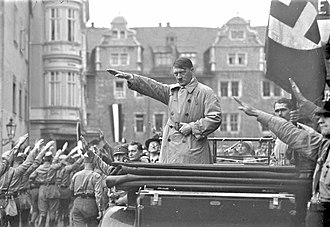
Meanwhile, a little Austrian-born fuckhead named Adolf Hitler, lacking any real-life skills, stayed with the army and joined the subversive and fascist German Worker's Party (DAP) to spy on it on behalf of the German government.[179] He very quickly became enchanted by its message of antisemitism and expansionist nationalism. He joined it and led it to rebrand as the National Socialist German Worker's Party (NSDAP), which would be better known as the Nazi Party. Hitler designed the party's swastika emblem, which has been used as a symbol by and for shitheads in the West ever since.[180] He then left the army and became notorious for giving rowdy and angry speeches to any group of people who would listen. By 1921, the Nazi Party recognized Hitler as one of their most influential public figures, and he was elected Party Chairman.[180] In late 1923, Hitler tried to launch the laughably failed Beer Hall Putsch in Munich, which landed him in prison for a few months.[181] From there, he wrote his shitty book Mein Kampf, which, along with the Great Depression and the resultant misery, caused the Nazi Party's popularity to explode. He presented a deranged fantasy world in which Germany was at war with the Jews running the capitalist system and simultaneously running the Soviet Union. According to him, it had also been the Jews who had sabotaged Germany in the last war.
Eventually, the increasingly popular Nazi Party started to win enough votes to cause deadlock in the Reichstag. Germany held presidential elections in 1932, and conservative Paul von Hindenburg ran against Adolf Hitler and the communist Ernst Thälmann. Hindenburg received broad support due to Hitler's extremism; traditional conservatives backed him, and liberals endorsed him as the lesser of two evils.[182] As a result, Hindenburg handily won the election. Unfortunately, more political deadlock set in, leading Hindenburg's conservatives to take the extraordinary step of encouraging the president to appoint Hitler as chancellor.
The Third Reich[edit]
“”Every national voluntary association, and every local club, was brought under Nazi control, from industrial and agricultural pressure groups to sports associations, football clubs, male voice choirs, women's organizations — in short, the whole fabric of associational life was Nazified. Rival, politically oriented clubs or societies were merged into a single Nazi body. Existing leaders of voluntary associations were either unceremoniously ousted, or knuckled under of their own accord. Many organizations expelled leftish or liberal members and declared their allegiance to the new state and its institutions. The whole process... went on all over Germany... By the end, virtually the only non-Nazi associations left were the army and the Churches with their lay organizations.
|
| —Richard Evans, The Third Reich in Power.,[183] |
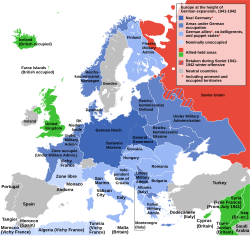
Nazi Germany and its influence at its maximum extent during the war.
.svg.png)
Flag of Nazi Germany.
.svg.png)
State emblem.
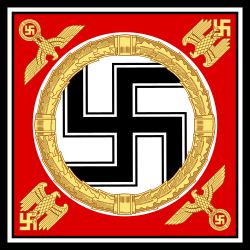
Personal standard of Adolf Hitler.
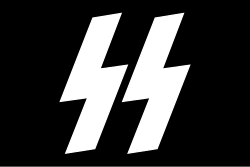
Flag of the Waffen-SS.
Consolidation of power[edit]
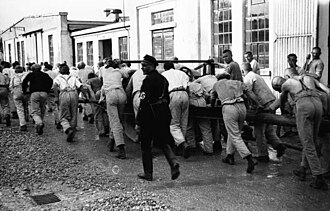
With so few people willing to defend the republic's institutions, Hitler had no trouble turning Germany into a totalitarian dictatorship. Shortly after Hitler became chancellor, the Reichstag building burned down under mysterious circumstances. Hitler and the Nazis promptly pinned the crime on a random communist and used it to justify the passage of the Reichstag Fire Decree.[184]
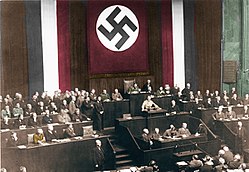
The decree suspended essential parts of Germany's constitution, removing the right to assembly, freedom of speech and freedom of the press and giving the German police the power to do whatever they wished.[185] It also gave Hitler the power to dissolve and overrule local governments, ban publications, and jail people without charge (removing the right of habeas corpus). Hitler then mobilized Nazi Party paramilitaries inside the Reichstag itself to force the parliament to pass the Enabling Act,[186] which granted Hitler the power to pass laws without consulting anyone else.
Hitler almost immediately ordered his subordinates to start creating the infamous concentration camps. Some were "temporary" detention centers for political opponents in empty warehouses, factories, and other convenient locations.[187] Over the next few years, these hastily constructed camps would be phased out and replaced with more secure and centrally-organized facilities under the watch of the Waffen-SS. Dachau, established in March 1933 south of Munich, became the model of this new kind of concentration camp,[187] mostly housing political opponents of the Nazi regime.[188] Dachau was quickly followed by many other concentration camps: Sachsenhausen (built 1936) north of Berlin, Buchenwald (1937) near Weimar, Neuengamme (1938) near Hamburg, Flossenbürg (1938), Mauthausen (1938), and Ravensbrück (1939).
After President Hindenburg died in 1934, Hitler had no more checks on his power. While the man was on his deathbed, Hitler forced the Reichstag to implement a law dissolving the office of the presidency after his death and merging it with the office of the chancellor.[189] He immediately granted himself the title Führer und Reichskanzler but subsequently amended it to Führer.[190]
Nazification[edit]
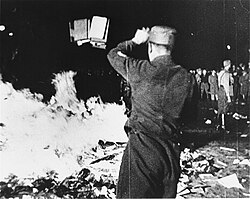
With his absolute power, Hitler completely transformed Germany into his own little playground. This was a program called Gleichschaltung, or "standardization", which sought to eliminate all independent institutions in Germany, whether political or otherwise.[191]

First, the Nazis declared themselves the only legal political party in Germany.[192] German civil servants were carefully screened for loyalty to Hitler, first with a 1933 law stipulating that officials "who were of non-Aryan descent" should be removed, then with other laws removing communists and later anyone the Nazi authorities didn't like.[191] Judges were removed from the bench for racial and political reasons, and those who remained were ordered to join the Nazi Party.[191] Hitler got around the German Supreme Court by having the Reichstag pass a law to remove much of its jurisdiction and establish a "People's Court" comprising Nazi Party officials.
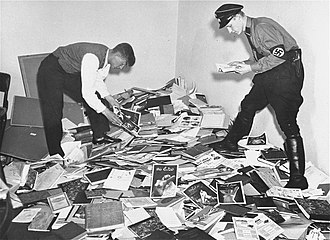
The Nazis then established the Ministry of Public Enlightenment and Propaganda under the leadership of Joseph Goebbels. This government ministry had complete control over magazines, newspapers, films, books, radio, television, public meetings, and even the arts.[193] As part of their propaganda effort, the Nazis ensured that their citizens would have no other source of information and would always be exposed to the Nazi Party's prejudices and ideals. As British historian Richard Evans, author of The Third Reich in Power, explains,[194]
Part of this program was the infamous spree of Nazi book burnings, which sought to destroy works written by Jews, liberals, antiwar activists, socialists, communists, you name them. Among the causes most harmed by this was equal rights for LGBT people. Nazis destroyed the entire works of the Institut für Sexualwissenschaft, which had produced a great volume of work arguing for equal rights, gay acceptance, and understanding of transgenderism.[195]
The Nazis introduced several compulsory Nazi Party organizations for the entire German youth to replace what they destroyed. Once reaching the age of 10, would join the Deutsches Jungvolk to be indoctrinated in Nazi ideology until the age of 14, at which point they would join the Hitler Youth (Hitlerjugend) until reaching adulthood.[196] Girls joined the Jungmädelbund as young children before moving on to the League of German Girls later, learning skills and doing activities the Nazis considered essential for women, such as household chores, physical exercise, and the importance of avoiding "racial defilement".[197]
To shore up loyalty to Hitler, the Nazi Party built a personality cult around him. Nazi propaganda effectively cast Hitler as a soldier at the ready, a father figure, and a messianic leader to redeem Germany from the interwar era's miseries. Hitler portrayed himself as the infallible embodiment of the German nation, and the Nazi Party assisted in this by mass-producing Hitler memorabilia like paintings, posters, busts, and millions of copies of Hitler's shitty Mein Kampf.[198] The German people were also legally required to greet each other with "Heil Hitler!" to the point that it became known as the "German greeting".[198][199]
Rearmament and expansionism[edit]

By the mid-1930s, Hitler had set Germany back on the path toward war, having reversed much of the short-lived progress made under the Weimar Republic. In 1933, Hitler announced to German military leaders the "conquest for Lebensraum in the East and its ruthless Germanisation" as his ultimate foreign policy objective.[201] Hitler also chose to prioritize military spending over welfare and unemployment relief.[202]
Germany's quest to regain its status as a military power proceeded rapidly. In 1935, Hitler took back the Saarland, and just a year later, he moved his armies into the Rhineland and ended its demilitarized status. Although the international community protested, most people reasoned that Germany was only recovering sovereignty over its territory.[203] Hitler then sent weapons and soldiers to fight in the Spanish Civil War, using the conflict as a giant proving ground for Germany's latest weaponry. During this time, he directed Hermann Göring to devise and execute a "Four Year Plan" to refocus Germany's economic potential towards industries useful for war production, like aluminum plants, synthetic oil refineries, and chemical plants.[204] Hitler's government managed to hide these efforts by funding them through a deferred payment scheme using promissory notes called "Mefo bills".[205] Economic efforts were also funded with property and capital confiscated from Jews.[206] Germany also saw great improvements in its infrastructure, especially the autobahn system. All was not well, though. Although unemployment had fallen dramatically, the average cost of living rose by 25%, and wages were stagnant.[207] The average German workweek also rose to 50 hours a week.
Internationally, Hitler eventually felt emboldened to pursue a dangerously aggressive foreign policy. In 1936, he forged an alliance with the fascist dictator Benito Mussolini of Italy and reached out to the Empire of Japan.[208] In 1938, German armies marched into Austria, annexing it to much Austrian joy.[209] Hitler then threatened war over the issue of claiming German-majority regions in Czechoslovakia, managing to get Britain and France to cave on the issue in the Munich Conference.[210] He violated the agreement less than six months later and sent troops to occupy the rest of Czechoslovak territory.[211]
Persecution of Jews[edit]
_(2704805986).jpg)
Nazi Germany also infamously began brutalizing its Jewish population even before the outbreak of the inevitable war. In September of 1935, the Reichstag passed the first anti-Jewish legislation, which would later be termed the "Nuremberg Laws" because they were announced during the Nazi Party's annual rally in Nuremberg. The first round of legislation banned marriage and sex between Jews and ethnic Germans.[212] Jews also had to wear insignia distinguishing themselves as Jews. Finally, Jews were stripped of their citizenship and reclassified as state subjects with no political rights.[212] In November, a subsequent amendment clarified who was considered a Jew with the infamous clause, "A Jew is an individual who is descended from at least three grandparents who were, racially, full Jews."[212] November also saw the Reichstag expand the laws to include Romani and black people.[213]
In 1937, the Nazis started requiring Jews to register all of their property with the government, thus making it available for arbitrary confiscation by the authorities. Once confiscated, these businesses would be "Aryanized" with the expulsion of Jewish owners and employees and the subsequent takeover by ethnic Germans. In late 1938, German authorities encouraged a massive pogrom against the country's Jewish population. Rioters attacked Jewish businesses, synagogues, schools, and even hospitals.[214] About 30,000 Jews were then arrested and carted off to concentration camps. Firefighters and emergency services were ordered not to intervene even in the many cases in which synagogues and other Jewish buildings burned.[215] This massive pogrom became known as Kristallnacht after the broken glass from the windows of synagogues, homes, and Jewish-owned businesses plundered and destroyed during the violence.
War without honor or humanity[edit]
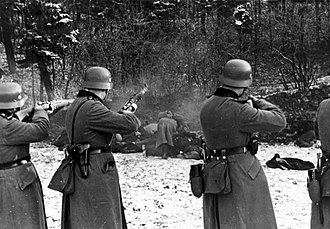
In September 1939, Hitler declared war on Poland, citing a bogus border incident.[216] Britain and France had finally had enough of Hitler's bullshit and stood up to him. Unfortunately, they did little to interfere with Hitler's invasion of Poland, allowing the German Wehrmacht to commit horrific atrocities. German atrocities in Poland began very quickly, and they had been explicitly ordered by Hitler in his August Obersalzberg Speech.[217] Hitler, during that speech, explained to his military brass that the goal of the war in Poland was not just conquest but outright extermination. The Nazi takeover and occupation of Poland featured indiscriminate extrajudicial executions, bombing raids on civilian areas, deportations, concentration camps, sending people into slave labor, and ethnic cleansing.[218]
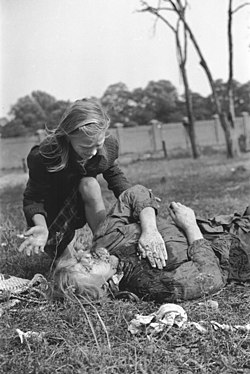
Nazi Germany then turned to the west, doing the classic move of invading Belgium (and the Netherlands) to reach Paris quicker. The Luftwaffe mercilessly bombed the Dutch city of Rotterdam flat[219] and used their occupation forces to send Jews into concentration camps.[220] The Nazis also had no compunctions about committing atrocities against the British and French, even though they considered them fellow Aryans. The Le Paradis massacre saw the SS murder 97 surrendered British soldiers,[221] and the Wormhoudt massacre saw SS soldiers murder 80 British and French POWs.[222] After France fell to the onslaught, the Nazis set up Vichy France as a puppet government and used it to deport tens of thousands of Jews to concentration camps, resulting in the deaths of 77,000 people.[223] During the Battle of Britain, the Luftwaffe launched mass air attacks against British cities, resulting in perhaps 40,000 civilian deaths.[224]
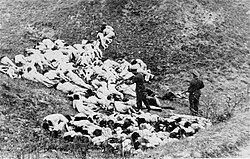
Hitler then invaded the Soviet Union in 1941 per his Generalplan Ost, which called for exterminating hundreds of millions of Slavic Europeans and colonizing all of eastern Europe with Germans.[225] Since the Germans planned to commit genocide on the Slavic ethnicities, they had no problem committing various hideous war crimes. Hitler issued the Barbarossa Decree, explaining that the war against the Soviet Union would be a war of extermination, calling for the murder of all Russian leaders and legalizing all war crimes committed by German soldiers.[226] German soldiers were ordered to deliberately mistreat women and children to ensure they didn't see the enemy as human.[226] Rape, murders, and beatings were thus commonplace. There were also incidents like the Khatyn massacre, where German soldiers destroyed entire villages.[227] The Germans abducted millions of people from occupied Poland and the Soviet Union to serve as slaves for German industry.[228] Despite their claims of upholding racial purity, the Nazis still went ahead and created camps for their soldiers to visit enslaved Slavic women to rape.[229] So many pregnancies occurred due to rape that Germany had to make "birthing centers" to dispose of the unwanted children, in which about 90% of the handled infants died due to neglect.[230]
Worst of all, Germany set about implementing the so-called Final Solution, in which it would exterminate all of Europe's undesirable populations, especially the Jews. As German troops advanced into the Soviet Union, specialized murder squads called the Einsatzgruppen followed the frontline troops to find and kill Jews and communists by the hundreds of thousands.[231] Beginning in late 1941, the Nazi government established "killing centers" across occupied Eastern Europe, based on the facilities the Nazis had previously built at home for Aktion T4.[232] Initially, some of these killing centers used trucks that had been refitted to gas the people inside with their exhaust fumes.[233] However, the infamous gas chambers were soon introduced as a more efficient alternative.[234]
The Nazis built many death camps designed solely to murder their inmates. Chelmno, Belzec, Sobibor, and Treblinka came first in occupied Poland, being built early in 1942 and having murdered collectively about 1.5 million people by the end of 1943.[232] These camps usually used exhaust to gas people in the chambers. Auschwitz-Birkenau in Poland was the largest of all the death camps, with four gas chambers using Zyklon B.[232] This camp brought about the deaths of more than a million people by itself. To keep these camps secret, the Nazis used Sonderkommandos to process the corpses. These unfortunate souls were also death camp inmates, and with few exceptions, they were eventually murdered themselves to prevent them from talking.[235]
Having fucked around, Germany finds out[edit]
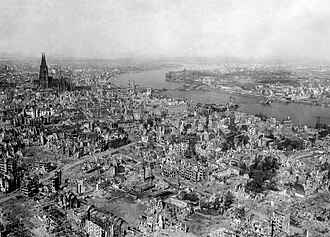
“”Hitler was the driving force behind the war. It was Hitler that provided its ideological basis and its strategic direction; his generals merely went along, however willingly. Hitler also had a hand in nearly all the major operational decisions concerning Germany's running of the war, and his was the leadership that took Germany and Europe into the greatest catastrophe of modern times.
|
| —Geoffrey P. Megargee, American WWII historian.[236] |
It ended up not being such a good idea to declare war on three continent-spanning empires while scrounging resources from within your own borders. By 1944, Germany had effectively lost the war, being broadly pushed back along the Eastern Front by a very pissed-off Soviet bear.
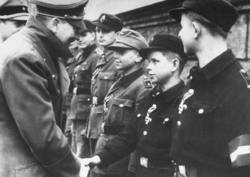
Although the war was lost, Hitler wasn't about to go out without ordering just a few more heinous atrocities and war crimes. After D-Day, the Western Allies had to face Germany on an open battlefield, and the Germans retaliated with their typical inhumanity. Examples include the Malmedy massacre, when Waffen-SS troops shot down 84 American POWs with machine guns,[237] or the Ardenne Abbey massacre when Hitler Youth child soldiers murdered 20 POWs from Canada.[238] Nazi wrath was also intensified against occupied France. Shortly after D-Day, SS troops destroyed the village of Tulle, killing 117 people and sending 149 others to Dachau, where 101 did not survive.[239] The SS did it again a few days later to the village of Oradour-sur-Glane, killing 642 French civilians.[240] Nazi occupation of northern Italy also came with a heavy civilian toll; they killed tens of thousands of innocent people native to their one-time ally.[241]
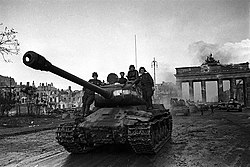
German desperation in the war's latter stages led to crimes against their own people. The Nazi government started using child soldiers to defend itself, largely drawn from the ranks of the Hitler Youth. Those young boys were not spared from summary execution as punishment for desertion or disobedience.[242] The more fanatical child soldiers went with Hitler into the grave. One of Hitler's last acts, occurring the day before he killed himself, was to decorate the Hitler Youth members defending his bunker, some as young as 11 or 12.[242]
Meanwhile, the Allies pounded Germany, hoping to drive it into submission. Strategic bombing by the Allies, targeted at cities with large industrial war production, ended up killing some 410,000 German civilians.[243] Unfortunately, even in the war's closing months, Germany's armies continued to inflict heavy losses on the Allies, and their own strategic bombing efforts still killed many thousands in the UK and France.[244]
The war ultimately became an apocalyptic battle within Berlin, with the German government refusing to surrender to spare their people further suffering. The massive battle left Germany's capital in ruins, while Soviet soldiers committed endless atrocities upon the German people in retaliation for the suffering their own people had gone through.[245] The battle ended with Hitler dead by cowardly suicide and the Nazi government capitulating.
Cold War division[edit]
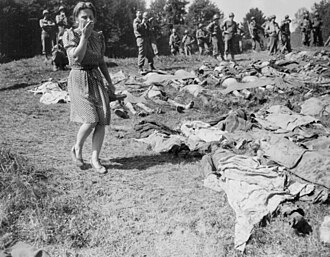
Occupation and de-Nazification[edit]
“”German civilians, 1200 of them, were brought from the neighbouring city of Weimar today to see for themselves the horror, brutality and human indecency perpetrated against the 'neighbours' at the infamous Buchenwald concentration camp. They saw sights that brought tears to their eyes and scores of them, including German nurses, just fainted away... Those who didn't weep were ashamed. They said they didn't know about it, and maybe they didn't, because the camp was restricted to army personnel. But there it was right at their back doors for eight years...
|
| —New York Times report, 18 April, 1945.[246] |
Germans refer to the immediate aftermath of the war as the Stunde Null (Zero Hour), the period during which Germany ceased to exist.[247] Germany had been dragged into oblivion by the Nazi regime; its cities were rubble, and millions of refugees streamed in from the east.
.gif)
With the German government effectively gone, the allies split Germany into four occupation zones and similarly split Berlin. The zones were governed by the Allied Control Council (ACC), consisting of the four supreme commanders of the Allied Forces. Its decisions had to be unanimous, or else nothing could happen. For instance, France vetoed the plan to create a central German-governed administration for the country, which made the country's division between east and west much easier.[248]
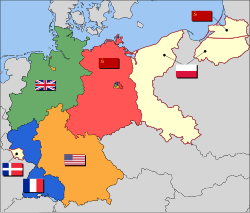
While all Allied powers agreed that Germany had to be rid of its Nazi ideology, implementing "de-Nazification" was inconsistent at best. France and the Soviet Union focused on exploiting its occupation zones for resources and reparations, while the US took the effort seriously but struggled to distinguish between who was to blame and who was merely dragged along.[249] A major part of the effort was the Nuremberg Trials, a series of Allied military tribunals that put German leaders on trial for their myriad war crimes.[250] The proceedings and evidence were widely publicized in Germany and abroad. Another prong of the effort saw British and American commanders force German civilians to tour the concentration camps and see for themselves the victims of German inhumanity.
Sadly, the onset of the Cold War distracted the Allies from the necessary process of destroying Nazism, meaning that the efforts made by all parties were largely over by 1948.[250] As a result, numerous Nazi criminals were able to escape justice.
While this happened, the US and the UK decided it would be more cost-effective if Germany could sustain itself. They merged their German territories into the "Bizone" and then invested in it to rebuild infrastructure.[251] Although France didn't want to see a revitalized Germany, they eventually joined their occupation zone, creating the "Trizone" in 1949. Trizone Germany benefited significantly from US Marshall Plan aid, which sent over $12 billion (equivalent to $130 billion in 2019) in economic recovery assistance to Western Europe.[252]
West Germany[edit]
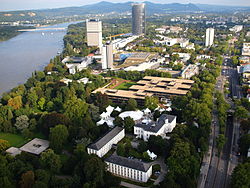
Angered by the increasing and unilateral integration of the Western Allies' portions of Germany, the Soviets attempted to blockade Berlin.[253] Rather than halting political unity in West Germany, the blockade accelerated it. All three western powers consented to a series of conventions that drafted a constitution and created the Federal Republic of Germany in the spring of 1949.[254] Its capital was in the city of Bonn, in the Rhineland. The relatively minor city of Bonn was chosen instead of one of West Germany's largest cities (Hamburg, Munich or Cologne) precisely because its previous lack of importance made it clear this was meant to be only a temporary capital; it was assumed at the time that reunification of Germany would happen relatively soon and Berlin would again become the capital.
The Federal Republic, or "West Germany", was designed specifically to avoid the pitfalls of the old Weimar Republic. The powers of the lower house of parliament, the Bundestag, and the federal chancellor were enhanced considerably at the expense of the federal president, who was reduced to a figurehead.[255] Germany also got a Federal Constitutional Court, which had the power to ban any political party aiming to obstruct or abolish the system of democracy.[255] Again, this provision was inspired by the many anti-democratic political parties active in the Weimar era. In 1952, the Socialist Reich Party, a direct successor to the Nazi Party, became the first German political party to be banned under the new laws.[256]
East Germany[edit]
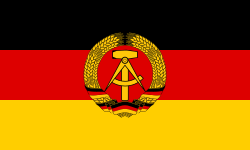
In response to the West German state, the Soviets held sham elections in their occupation zone. Voters used non-secret ballots and could only choose among various communist-controlled parties.[257] Within the Soviet zone, the Socialist Unity Party of Germany (SED) was the dominant political force, naturally governing along Marxist-Leninist principles.[258]
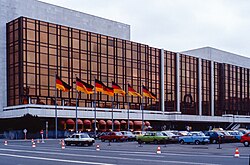
The SED, with Soviet consent, created the German Democratic Republic, or "East Germany". Its parliament, the Volkskammer (People's Chamber), was an empty shell meant only for mock debates and grand speechifying.[259] In reality, all policy matters were decided by the Politburo of the SED, a body organized to mirror the Politburo of the Soviet Union.[259]
East Germany became a model dictatorship in the Eastern Bloc. Its rule was enforced by a secret police organization called the Ministry for State Security, or the "Stasi." The Stasi turned East Germany into an enormous surveillance state through a web of informants, a web so huge that it's estimated that there was one informant for every 6 citizens.[260] They were so stupidly paranoid that they sent agents to investigate things like footballs kicked over fences or trash tossed on the street.[260] The Stasi also created the Zersetzung, a method of psychological warfare that involved intentionally damaging the mental health of suspected dissidents through harassment and gaslighting.[261] Failing that, there was always the Hohenschönhausen, a sophisticated torture facility and state prison.[262]
Soviet forces remained in East Germany throughout the Cold War. Russian language and Marxist-Leninist thought were mandatory in East German schools.[263] Emigration to the West became a significant problem, as Germans surprisingly didn't want to stick around inside a country that watched their every move and didn't let them participate in government. Who woulda guessed?
The Berlin Wall[edit]
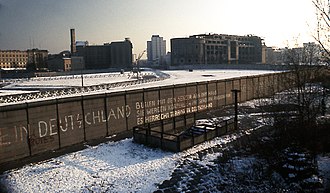
In response to the massive human exodus out of East Germany (around 2.7 million people left the GDR and East Berlin between 1949 and 1961[264]), East German leaders decided that the people needed to be forced to stay. In 1961, East Germany closed its border with West Germany and West Berlin. The GDR's Council of Ministers announced that "in order to put a stop to the hostile activity of West Germany’s and West Berlin’s revanchist and militaristic forces, border controls of the kind generally found in every sovereign state will be set up at the border of the German Democratic Republic, including the border to the western sectors of Greater Berlin."[264] This heralded the construction of the Berlin Wall, an infamous symbol of communist tyranny.
The interesting part was that the Soviet Union opposed the move, arguing that it would be too logistically difficult and make the Eastern Bloc look bad in front of the world.[265] It took several years of constant East German bitching to convince the Soviets to greenlight the project.
The Berlin Wall sealed off West Berlin, that small part of the city that had been under the jurisdiction of the Western powers and had been handed off to West Germany. The wall repeatedly expanded in scope, eventually becoming a vast series of layered fortifications, kill towers, minefields, and electric fences.[266] Border fortifications were not enough to deter would-be escapees, so the border guards had orders to kill anyone trying to cross illegally if they could not be prevented by other means.[267] About 90 people were murdered in this way between 1961 and 1989. Including those who died by accident or committed suicide rather than return to communist tyranny, the number increases to 101.[268]
While more famous, the Berlin wall wasn't the only fortification guarding the East German prison. There was also a less intense set of fortifications along the "inner German border", the border between East and West Germany that stretched for about 1,400 kilometers.[269]
1968 cultural revolution[edit]
.jpg)
“”What the anti-authoritarian revolution of the 1960s achieved has a lot of significance. Back then, the Nazis' authoritarian way of thinking was still strongly anchored in people's minds. The concept of total obedience was still prevalent. That has changed enormously. People today are far more critical; they're capable of thinking independently and there's more room for creativity. The population has widely adopted the concept of democratization of society.
|
| —Gretchen Dutschke, widow of the late protest leader Rudi Dutschke.[270] |
In same year that cultural and workers' protests shook France to the core, a similar movement took hold in (primarily West) Germany. The preceding decades had brought renewed prosperity to Germany, but many liberal and leftist students resented that the greatest share of that wealth was only for the rich.[271] It took off even further when students protested against a state visit from the Shah of Iran, sparking a violent police response that left a student killed.[272]
.jpg)
As in France, the movement took on a broader context in the growing tensions between the younger generations and the older. Young Germans had come of age and entered universities and were enraged to discover just how influential the old Nazi and militarist ways still were among much of the older generation.[273] They were especially enraged that Kurt Georg Kiesinger was chancellor despite being a former member of the Nazi Party (albeit very inactive).[274] Frustration towards him was beautifully expressed in 1968 when German woman and hunter of war criminals Beate Klarsfeld slapped Kiesinger in the face during a Christian Democratic Union party congress.[275]
.jpg)
One of the movement's leaders, the Marxist Rudi Dutschke, suffered an assassination attempt by a far-right bitch who had apparently been inspired by the successful killing of Martin Luther King Jr.[276] Dutschke survived but suffered health effects from the bullet he took to the head for the rest of his shortened life. The protests intensified as students blamed the German media for inciting the attack.
West German police often responded violently, especially since former Nazis were often in uniform (of course), and they didn't hesitate to beat the shit out of protesters.[272] While most students stayed peaceful, a radical splinter group that called itself the "Red Army Faction" committed acts of terrorism, including kidnapping and murdering a famous German businessman who they revealed had actually been an organizer of the Nazi Student Organization.[277]
Despite the suppressed protests, they had a broad cultural impact on Germany. Students got more influence over university direction, women were given more educational opportunities, and the government committed to more education efforts.[277] However, the real legacy was the harsh exposure of longstanding societal ills like income inequality, gender inequality, and Germany's struggle to come to terms with its past.
Reunification[edit]
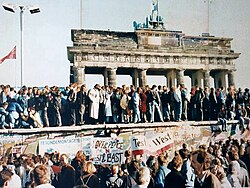
Back in the Eastern Bloc, economic and cultural stagnation had taken a hard toll on all communist nations. Poland and Hungary fell first in 1989, with the Soviet Union refusing to intervene due to the overextension concerns of Mikhail Gorbachev. During Hungary's transition from communism, its government dismantled its electric border fence with Austria. This punched a huge hole in the no-longer-Iron Curtain that East Germans immediately started to exploit.[278] The border walls had only suppressed their desire to get the fuck out of commie land, not removed it.
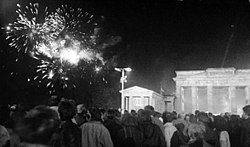
This created a massive refugee crisis as hundreds of thousands of East Germans fled into their neighboring countries, either hoping to reach Austria or else reach a Western Bloc embassy.[279] At the request of East Germany's leadership, Czechoslovakia closed its borders to East Germans to stop East Germans from reaching Hungary.[280] East Germany also shut down its border with Poland. However, by bottling up the East German population inside their own country, the East German leadership made it clear that they would not be following the path of reform that Poland and Hungary took. And that pissed the East Germans right off. East Germans started staging a series of large protests called the Monday demonstrations that the government repeatedly tried and failed to suppress.[281] The government began to consider conducting a mass crackdown in the style of the Tiananmen Square Massacre but decided against this due to East Germany's reliance on loans from the West and the lack of military support from the Soviet Union.[282]
During a press conference, an abrupt gaffe from party functionary Günter Schabowski caused East Germans to think that the government's policy would change and that the border would be opened imminently.[283] Seemingly the entire population of East Berlin and its surrounding areas shat a brick at the news. People mobbed the Berlin Wall security checkpoints, and none of the officials or soldiers were willing to take responsibility for acting on the spot. Thus, they had little choice but to start letting people through.[284] East German civilians held an impromptu celebration there, and the situation was too chaotic for the East German authorities to regain control.
With absent Soviet support and total loss of control over their population, the East German government collapsed in short order. East Germany held free elections in March 1990, and the Christian Democratic Union won on a platform of speedy reunification with West Germany.[285] One abrupt integration process later, Germany was made whole again in October 1990.
Modern Germany[edit]
“” Germany is a strong country.
|
| —Chancellor Angela Merkel, 2015.[286] |
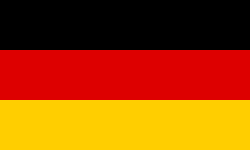
Flag of the Federal Republic.
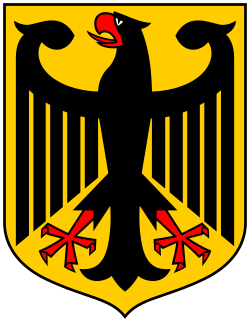
German coat of arms.

Iron Cross emblem of the Bundeswehr.
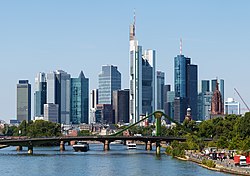
Reunification proved to be a bit of a problem after reality set in. After stagnating for decades on both an economic and cultural level, East Germany proved to be a bitter pill for the progressive West German democracy to swallow. One big issue was property rights, as the Soviets had appropriated a shitload of material and many West Germans still thought they were entitled to old family holdings in the east.[287] Lawsuits ensued and tied up German courts, making investors nervous and creating an atmosphere of confusion. East Germany also had shitty power stations, almost no telephone coverage, and horribly maintained roads and railroads.[287] But the biggest challenge was transitioning the east into a market economy after so many decades of command markets, with all of these issues costing Germany the equivalent of $2 trillion.[288] Goddamn. (This also should to raise some uncomfortable questions about the viability of Korean reunification).
Despite these challenges, Germany has emerged as a global leader. It spearheaded the formation of the European Union and still serves as one of, if not the, most important members of the economic bloc.[289] Germany also maintains its ties with NATO, sending troops to keep the peace in Bosnia after the Yugoslav Wars and maintaining a longstanding presence in the Afghanistan War alongside their American allies.[290]
Germany currently focuses on promoting European integration, energy transition to renewables, and attempting to integrate a massive wave of migrants from the Middle East. Under its chancellor Angela Merkel, Germany became a European leader in accepting refugees, and so far, the migrants seem to be integrating well, according to international observers.[291] Unfortunately, the crisis did cause an upsurge in far-right and xenophobic politics that Germany is still struggling to deal with.
Government and politics[edit]
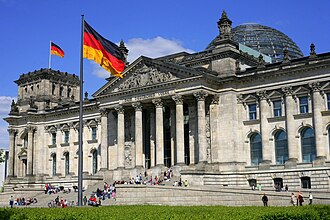
Structure[edit]
The Federal Republic was explicitly constructed to avoid the pitfalls that doomed the Weimar Republic. A pretty smart thing to do. The German constitution, written in 1949, first outlines some basic human rights all Germans are entitled to, including equality before the law, freedom of speech, assembly, the news media, and worship.[292] However, the constitution also explicitly states that any political activities that endanger German democracy are not entitled to those rights. This is to ensure that, unlike Weimar, the current German republic can actually defend itself from those assholes who would see it end (primarily meaning neo-Nazis).
The true power in Germany rests with the Bundestag, its parliament. Again, this is a major difference from the Weimar Republic, which vested most of its power in the president. The German parliament is bicameral, with the 709-seat Bundestag as its lower house[293] and the 69-seat Bundesrat as the upper house, representing the German states.[294] The Bundestag is elected every four years by German citizens over 18 using a mixed-member proportional representation system. Members of the Bundesrat are appointed by state governments.
The German president has relatively few powers, almost to the point of being a figurehead. This is intentional, as the German president played a major role with his extensive powers in helping Adolf Hitler dismantle the Weimar Republic.[295] Real power rests with the German chancellor, who is elected by the Bundestag.[296] The current chancellor is Friedrich Merz, who has been in office since May 2025.
Finally, it is important to note that Germany, somewhat unusually for a European country, has a federal system, which dates back to the federal nature of the German Empire in 1871. State governments hold significant authority, and the federal government can only wield those powers that were explicitly given to it by the constitution.[297] States manage such affairs as law enforcement, education, welfare programs, and tax collection.
Political parties[edit]

Germany has a bunch of political parties, although relatively few have any major impact on the country's politics. Still, unlike in the United States, more than two are capable of making their way into the legislature.
The Christian Democratic Union (CDU), the party of former Chancellor Angela Merkel, represents moderate right-wing interests and has been in power for most of the time since World War II.[298] Their sister party, the Christian Social Union (CSU), runs candidates solely in the state of Bavaria.[299] Both parties support capitalism with a welfare system but tend to be socially conservative.[300]
Germany's oldest party, the Social Democratic Party (SPD), is on the other end of the spectrum. Once an outright social democratic organization, the SPD moderated itself significantly to continue being viable in an environment where Germany became fairly prosperous and built a decent welfare state; it now focuses on expanding those welfare programs and doesn't want to rock the boat too much.[301] In fact, it may have compromised too much for its own good, as before 2021, the party had suffered increasingly disastrous results in German elections due to many of its voters defecting to the Green Party to focus on climate change.[302]
On the fringes are the Left Party (Die Linke), which has effectively inherited supporters and platforms from the old East Germany (albeit without the dictatorship bit), and the Alternative for Germany Party (AFD), a far-right populist, Eurosceptic, climate science-denying, and anti-immigrant group of reactionaries.[303]
And then there's the supposedly market-liberal Free Democratic Party (FDP). While being very prominent in the early Federal Republic, their popularity dwindled to the point of being just another populist shitshow. These days, they're trying to lure possible fat-cat voters with promises of a much less regulated laissez-faire market in contrast to Germany's current system of a social market economy.
Foreign relations[edit]
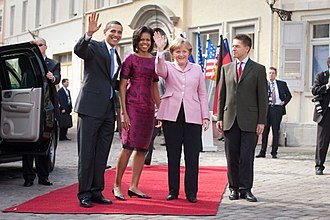
After destroying much of the world during World War II, Germany successfully rebuilt its global image to a large degree. Germany and France, for instance, are on excellent terms now and, in 2019, teamed up to promote multilateralism in an era of selfish nationalism.[304] They also function as the power couple driving much of the European Union's agenda. Greece, for instance, discovered this fact to its chagrin during the Greek debt crisis when Germany stuck to an austerity policy and refused to adjust fiscal policy to help the Greeks.[305] Merkel was, understandably, not very popular in Greece at the time. Germany has also historically pushed for greater integration of Europe, both through deepening ties that already exist and drawing more countries into the EU.[306] Hopefully, they're not playing the long game to create the Fourth Reich.
Germany is also a loyal partner in NATO, although it was criticized by US President Donald Trump during his first term in office for failing to meet the alliance's 2% of GDP spending on defense matters.[307] Despite Trump being his usual piece of shit self, Germany actually answered by hiking up its defense budget by a significant degree, even apparently planning to stick to it after Trump departed from office.[308] The US' treatment of its stalwart ally was remarkably ungrateful, considering that 57 Germans gave their lives in Afghanistan in the fight against the Taliban and Al Qaeda in a war that the US called them on.[309]
Ban against Nazism[edit]

“”Whoever fights against the basic values of our free society will get to feel the resolute reaction of our government. There’s no place in this country for an association that sows hatred and and works on the resurrection of a Nazi state.
|
| —Interior Minister Horst Seehofer, December 2020.[310] |
The German government has the power to ban anti-democratic organizations, and every now and then, it sees fit to use that power. As recently as December of 2020, German police were sent to raid homes across three German states to root out a far-right group called Wolfsbrigade 44.[310] The group reportedly wanted to reestablish the Nazi dictatorship and named itself after SS officer Oskar Dirlewanger, a strong candidate for one of the evilest people ever. In other words, Germany has a pretty damn good reason for banning certain groups and symbols.
The swastika, meanwhile, has been banned in Germany since the Allied occupation, as was Mein Kampf, the phrase "Heil Hitler!", and the Nazi Party itself.[311] Amid more problems with hate crimes, Germany broadened its laws against any speech targeting hatred at a population, making Holocaust denial illegal. Unfortunately, there was a temporary absurdity where German authorities started cracking down on anti-Nazi symbols since the law failed to distinguish between a swastika and a swastika that was crossed out or dumped in the trash.[312]
This grew into a German concept called "defensive democracy", the idea that the republic should use all methods at its disposal to ensure that human rights and democracy survive in Germany, even to the extent that the methods become un-democratic. In Germany, this mission is left up to the Office for the Protection of the Constitution (BFV), a domestic-intelligence agency to root out neo-Nazis and Islamic terrorists.[313]
Still, hateful fucks find a way, even in Germany. In the absence of the swastika, far-rightists have taken to flying the American Confederate flag as a replacement symbol, realizing where many American conservatives don't that the flag stands for racism and white supremacy.[314]
Resurgent far-right[edit]
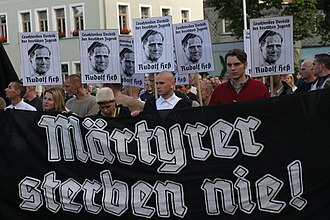
Sadly, the above measures haven't prevented the German far-right from gaining power. The National Democratic Party of Germany, for instance, is a neo-Nazi party that has been a headache for decades. An effort to ban them failed in 2003 because the German government had infiltrated them, and its agents had written much of the material being presented against them in court.[315] Fucking oops. The party never got into the national Bundestag, but it did gain some seats in state legislatures. Those states were in the former East Germany, which raises a much bigger issue.
East Germany, with its lagging economy and rough adjustment to capitalism, became a stronghold for the radical right after reunification, to the point where violent fuckhead mobs have attacked asylum seekers and immigrants.[316] The problem has only gotten worse too. In 2019, the city of Dresden declared a "Nazi Emergency" (no, really) due to years of right-wing extremist violence and rallying.[317] It's no coincidence that Dresden was the birthplace of PEGIDA.
The AfD Party's rising popularity has also primarily taken place in the east, a situation related to the rise in neo-Nazism. AfD's leader in the state of Thuringia, Bjorn Hoecke, was under investigation for questioning Germany’s culpability in World War II and using the term lebensraum.[318] Hoecke also said that Germany's efforts to acknowledge the Holocaust and other Nazi crimes were somehow bad.[319] The AfD as a whole is now under nationwide surveillance by German intelligence agencies fearing that they threaten democracy.[320]
Meanwhile, Germany must investigate its police forces for rampant racism and far-right views.[321] The country has also seen an alarming rise in far-right terrorist attacks.[322]
States of Germany[edit]
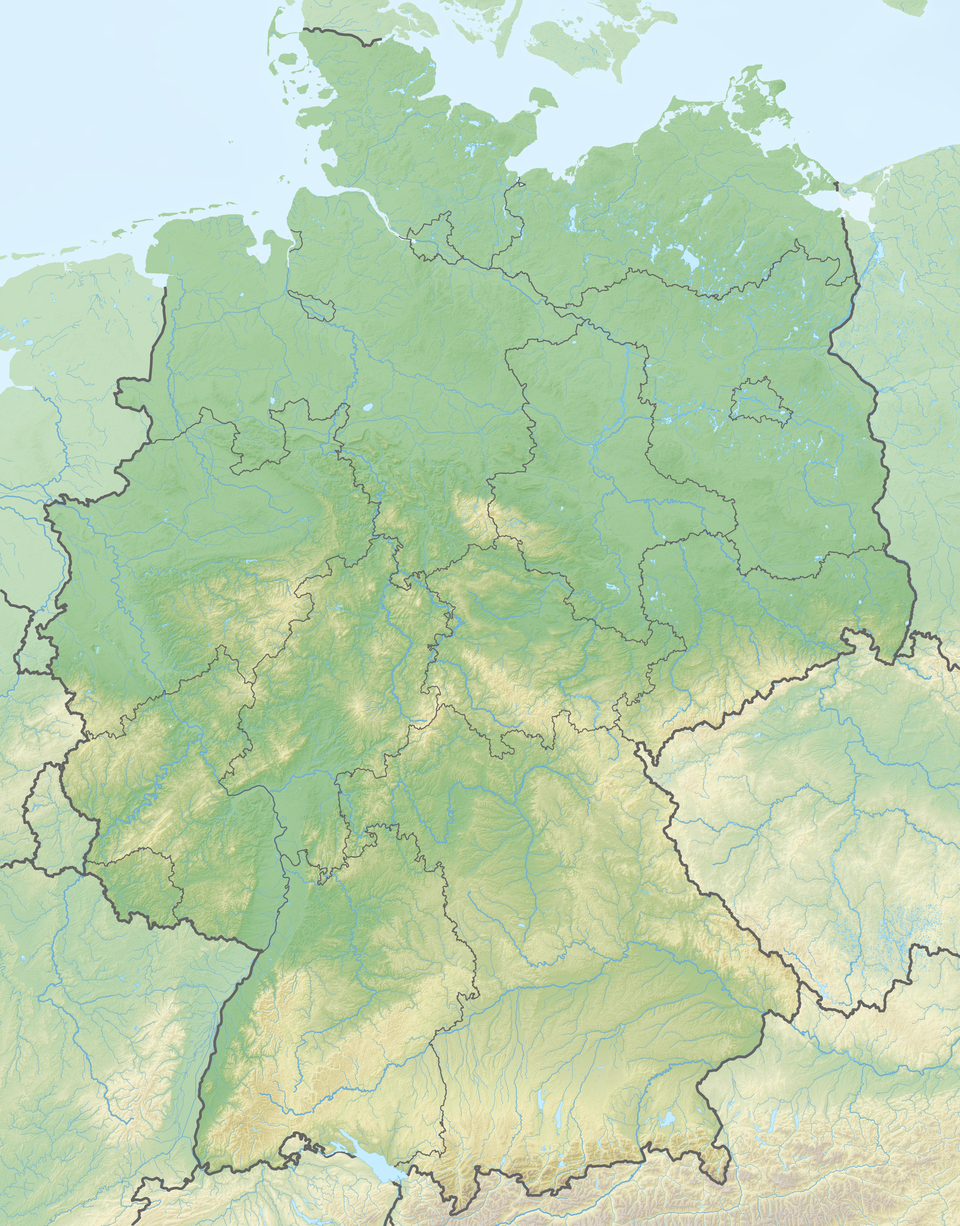
Ocean
| Arms | State (English name) | Capital (English name) | Other notable cities (English name) |
|---|---|---|---|
| Stuttgart | Heidelberg Heilbronn Karlsruhe Ulm | ||
| München (Munich) | Augsburg Ingolstadt Nürnberg (Nuremberg) Regensburg Würzburg | ||
| Berlin | |||
| Potsdam | Brandenburg an der Havel Cottbus Frankfurt an der Oder | ||
| Bremen | Bremerhaven | ||
| Hamburg | |||
| Wiesbaden | Frankfurt am Main | ||
| Hannover (Hanover) | Braunschweig (Brunswick) Oldenburg | ||
| Schwerin | Rostock Rügen | ||
| Düsseldorf | Aachen Bonn Köln (Cologne) Dortmund Essen Münster | ||
| Mainz | Trier | ||
| Saarbrücken | |||
| Dresden | Chemnitz Leipzig | ||
| Magdeburg | Halle | ||
| Kiel | Lübeck Flensburg | ||
| Erfurt | Jena Weimar |
Gallery[edit]
.jpg)
View of Berlin.
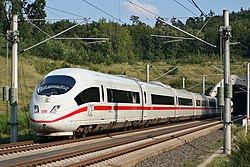
Train on the Cologne–Frankfurt high-speed rail line.
Germans donating to fight pediatric cancer.
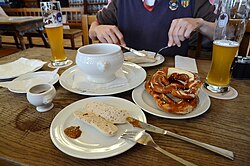
Meal in Bavaria: weisswurst, pretzels, and beer.
Mount Zugspitze in southern Germany.

Black Forest cake.
.jpg)
Skyline of Cologne with its iconic cathedral.
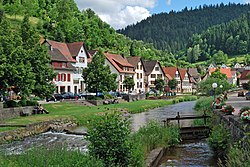
A small town in the Black Forest of Baden-Württemberg.

Germany's national football team celebrates winning the 2014 FIFA World Cup.
External links[edit]
- Why are so many European royal families German? a short video by History Matters on Youtube. Also,
- What Happened to Prussia?
- How did the World React to the Unification of Germany?
- Why did the Weimar Republic Fail?
- Why was Germany allowed to rearm after World War 2?
- Who opposed German Reunification?
References[edit]
- ↑ Germany. Wikiquote.
- ↑ Germany takes EU hot seat with big challenges, expectations. Associated Press.
- ↑ 22 Things No One Does Better Than The Germans. Kiwi Report.
- ↑ 5 facts about cannabis laws in Germany. Deutsche Welle.
- ↑ 5.0 5.1 See the Wikipedia article on Religion in Germany.
- ↑ Germanic peoples. Britannica.
- ↑ Brown, Robert D. (2013). "Caesar's Description of Bridging the Rhine (Bellum Gallicum 4.16–19): A Literary Analysis". Classical Philology. 108: 41–53. doi:10.1086/669789. S2CID 162278924.
- ↑ 8.0 8.1 Arminius. Ancient History Encyclopedia.
- ↑ Battle of Teutoburg Forest. Ancient History Encyclopedia.
- ↑ 10.0 10.1 10.2 10.3 The Germanic Tribes. Lumen Learning.
- ↑ Roman Gaul. Ancient History Encyclopedia.
- ↑ Odoacer. Ancient History Encyclopedia.
- ↑ Franks. Ancient History Encyclopedia.
- ↑ See the Wikipedia article on Saint Boniface.
- ↑ Was Charlemagne a Mass Murderer? Medievalists.net
- ↑ See the Wikipedia article on Aachen Cathedral.
- ↑ The Carolingian Dynasty, 752-911. Country Studies.
- ↑ Quotation Details. The Quotations Page.
- ↑ history of the entire world, i guess
- ↑ Cantor, Norman F. (1994). The Civilization of the Middle Ages. Harper Perennial. ISBN 978-0-06-092553-6. 214–15
- ↑ 21.0 21.1 The Investiture Controversy. Lumen Learning.
- ↑ See the Wikipedia article on Concordat of Worms.
- ↑ John, Simon (2017). Godfrey of Bouillon: Duke of Lower Lotharingia, Ruler of Latin Jerusalem, c.1060-1100. Taylor & Francis. ISBN 978-1-317-12630-0. p. 186-187.
- ↑ Freed, John (2016). Frederick Barbarossa: The Prince and the Myth. New Haven, CT: Yale University Press. ISBN 978-0-300-122763. p. 51–53
- ↑ Loud, G. A. (2010). The Crusade of Frederick Barbarossa: The History of the Expedition of the Emperor Frederick and Related Texts. Farnham, Surrey: Ashgate Publishing. ISBN 9780754665755. p. 64.
- ↑ The Hohenstaufen Dynasty, 1138-1254. Country Studies.
- ↑ Teutonic Order. Britannica.
- ↑ See the Wikipedia article on Rhineland massacres.
- ↑ Richard S. Levy. Antisemitism: A Historical Encyclopedia Of Prejudice And Persecution, ABC-CLIO, 2005, ISBN 9781851094394. p. 153.
- ↑ 30.0 30.1 The Empire under the Early Habsburgs. Country Studies.
- ↑ The German Renaissance.
- ↑ The Gutenberg Press. Oregon State University.
- ↑ The Day Martin Luther Was Excommunicated Herman Selderhuis, Crossway, January 03, 2018
- ↑ Germany: The Protestant Reformation. Country Studies
- ↑ Indulgence. Britannica.
- ↑ Martin Luther. Biography.com
- ↑ The Edict of Worms (1521)
- ↑ Reformation Europe: 1517–1559, London: Fontana, 1963, 53; Diarmaid MacCulloch, Reformation: Europe's House Divided, 1490–1700, London: Allen Lane, 2003, 132.
- ↑ Luther, Martin. "Letter 82," in Luther's Works. Jaroslav Jan Pelikan, Hilton C. Oswald and Helmut T. Lehmann (eds), Vol. 48: Letters I, Philadelphia: Fortress Press, 1999, c1963, 48:246; Mullett, 133.
- ↑ Anti-Semitism: Martin Luther - “The Jews & Their Lies”. Jewish Virtual Library.
- ↑ See the Wikipedia article on Knights' Revolt.
- ↑ 42.0 42.1 42.2 42.3 German Peasants War (1524 – 1525): Uprising of the Poor. ThoughtCo.
- ↑ Peasants War. Encyclopedia.com
- ↑ Schmalkaldic League. Britannica.
- ↑ See the Wikipedia article on Schmalkaldic War.
- ↑ See the Wikipedia article on Second Schmalkaldic War.
- ↑ Peace of Augsburg. Britannica.
- ↑ See the Wikipedia article on Cologne War.
- ↑ See the Wikipedia article on Destruction of Neuss.
- ↑ See the Wikipedia article on Siege of Godesberg.
- ↑ See the Wikipedia article on Protestant Union.
- ↑ See the Wikipedia article on War of the Jülich Succession.
- ↑ 53.0 53.1 Germany: The Counter-Reformation and Religious Tensions. Country Studies.
- ↑ The French Religious Wars 1562-1598 (Essential Histories) Robert Knecht.
- ↑ Persecutor of the Protestants: Ferdinand II World of the Habsburgs. ND.
- ↑ Wedgwood, CV (1938). The Thirty Years War (2005 ed.). New York Review of Books. ISBN 978-1590171462. p. 137
- ↑ See the Wikipedia article on Edict of Restitution.
- ↑ Wedgwood, CV (1938). The Thirty Years War (2005 ed.). New York Review of Books. ISBN 978-1590171462. p. 385-386
- ↑ The Thirty Years' War
- ↑ Military developments in the Thirty Years' War C N Trueman "Military Developments In The Thirty Years' War" historylearningsite.co.uk. The History Learning Site, 25 Mar 2015.
- ↑ White, Matthew. "The Thirty Years' War (1618-48)". Necrometrics. ND.
- ↑ Westphalia, Peace of Bardo Fassbender, Oxford Public International Law, Feb. 2011 (section B10)
- ↑ Germany: The Age of Enlightened Absolutism, 1648-1789. Country Studies.
- ↑ Germany: Austria and Prussia. Country Studies.
- ↑ The Kingdom of Prussia is Founded. History Today.
- ↑ Rise of Prussia. Heritage History.
- ↑ Frederick William I (Prussia) (1688–1740; Ruled 1713–1740). Encyclopedia.com
- ↑ See the Wikipedia article on Pragmatic Sanction of 1713.
- ↑ Frederick the Great. Heritage History.
- ↑ 70.0 70.1 70.2 The Ultimate Guide to Enlightened Absolutists for AP® European History.
- ↑ Germany: Austria and Prussia. Country Studies.
- ↑ 72.0 72.1 Germany: The Smaller States. Country Studies.
- ↑ See the Wikipedia article on Baroque architecture.
- ↑ Partitions of Poland. Britannica.
- ↑ Sheehan, James J. (1989). German History: 1770–1866. pp. 75, 207–291, 291–323, 324–371, 802–820.
- ↑ See the Wikipedia article on Marie Antoinette.
- ↑ See the Wikipedia article on Declaration of Pillnitz.
- ↑ War of the First Coalition in 1790s France. ThoughtCo.
- ↑ Wilson, Peter H. (2009). "The Meaning of Empire in Central Europe around 1800". In Forrest, Alan; Wilson, Peter H. (eds.). The Bee and the Eagle: Napoleonic France and the End of the Holy Roman Empire, 1806. Palgrave Macmillan. ISBN 978-0-230-00893-9. p. 26.
- ↑ Prussia – the Third Coalition and the Battle of Austerlitz. Foundation Napoleon.
- ↑ See the Wikipedia article on Battle of Austerlitz.
- ↑ See the Wikipedia article on Peace of Pressburg (1805).
- ↑ The End of the Holy Roman Empire. History Today.
- ↑ The French Revolution and Germany. Country Studies.
- ↑ See the Wikipedia article on Congress of Vienna.
- ↑ The German Confederation, 1815-66. Country Studies.
- ↑ Germany: Results of the Congress of Vienna. Britannica.
- ↑ Johann Gottlieb Fichte: To the German Nation, 1806. Internet History Sourcebooks, Fordham University.
- ↑ German Unification. Lumen Learning.
- ↑ Germany: Economic and Political Trends Toward Unification. Country Studies.
- ↑ The Revolutions of 1848. Country Studies.
- ↑ Frankfurt National Assembly. Britannica.
- ↑ The German Revolutions of 1848. Lumen Learning.
- ↑ 94.0 94.1 Karl Marx. Biography.com
- ↑ The revolutionary socialist: 200 years of Friedrich Engels. Deutsche Welle.
- ↑ See the Wikipedia article on German Question.
- ↑ Grossdeutschland or Kleindeutschland. BBC History.
- ↑ "The Situation of Germany". (PDF) The New York Times, July 1, 1866.
- ↑ Hollyday, F. B. M. (1970). Bismarck. Great Lives Observed. Prentice-Hall. ISBN 978-0-13-077362-3. pp. 16–18.
- ↑ Germany: Bismarck and Unification. Country Studies.
- ↑ https://www.icrc.org/en/doc/resources/documents/misc/57jnvu.htm#:~:text=In November 1863, the death,and Prussian armies invaded Denmark.
- ↑ 102.0 102.1 1864: A History of the Second Schleswig War.
- ↑ See the Wikipedia article on Kiel Canal.
- ↑ German-Danish War. Britannica.
- ↑ See the Wikipedia article on Third Italian War of Independence.
- ↑ See the Wikipedia article on Austro-Prussian War.
- ↑ Seven Weeks War. Britannica.
- ↑ See the Wikipedia article on Austro-Prussian War.
- ↑ 109.0 109.1 Austro-Prussian/ Seven Weeks War, June-August 1866. History of War.
- ↑ James Minahan. One Europe, Many Nations: A Historical Dictionary of European National Groups. Greenwood Publishing Group, Ltd., 2000. P. 106.
- ↑ See the Wikipedia article on Ems Dispatch.
- ↑ Howard, Michael. The Franco-Prussian War. New York: Dorset Press. 1990 (originally published in 1961). ISBN 0-88029-432-9 p. 55.
- ↑ 113.0 113.1 Franco-German War. Britannica.
- ↑ Napoleon III, Emperor of the French. Napoleon.org
- ↑ Wilhelm II, German Emperor. Wikiquote.
- ↑ William I, German Emperor. Wikiquote.
- ↑ Proclamation of the German Empire, 1871. Chateau de Versailles.
- ↑ See the Wikipedia article on Constitution of the German Empire.
- ↑ Governments, Parliaments and Parties (Germany). International Encyclopedia of the First World War.
- ↑ Imperial Germany. Country Studies.
- ↑ 121.0 121.1 Germany: Domestic concerns. Britannica.
- ↑ 122.0 122.1 122.2 Kulturkampf. Britannica.
- ↑ Anti-Socialist Law (October 21, 1878).
- ↑ Bismarck Tried to End Socialism’s Grip—By Offering Government Healthcare. Smithsonian Magazine.
- ↑ Otto von Bismarck. US Social Security Administration.
- ↑ Berlin Conference of 1884–1885 Oxford Reference
- ↑ 130 years ago: carving up Africa in Berlin Fischer, Hilke. Deutsche Welle
- ↑ German Kamerun (1884–1916). Britannica.
- ↑ ‘They Handle Negroes Just Like Us’: German Colonialism in Cameroon in the Eyes of Poles (1885–1914). Cambridge.
- ↑ German-Herero conflict of 1904–07 Britannica
- ↑ Germany moves to atone for 'forgotten genocide' in Namibia Burke, Jason. The Guardian.
- ↑ Germany Grapples With Its African Genocide Onishi Norimitsu. New York Times
- ↑ 133.0 133.1 Ending the silence around German colonialism. Open Democracy.
- ↑ Röhl, John C.G. (2014). Kaiser Wilhelm II: A Concise Life. Cambridge, England: Cambridge UP. p. 44. ISBN 9781107072251.
- ↑ Alsace-Lorraine. Britannica.
- ↑ Taylor, A.J.P. (1988). Bismarck: The Man and the Statesman. Hamish Hamilton. p. 133. ISBN 0-241-11565-5.
- ↑ Terminating the Reinsurance Treaty with Russia (1890).
- ↑ How an ill-considered pact brought war, dictatorship, and the bomb; The Fateful Alliance: France, Russia, and the Coming of the First World War. Christian Science Monitor.
- ↑ Naval Race between Germany and Great Britain, 1898-1912. International Encyclopedia of the First World War.
- ↑ Moroccan crises. Britannica
- ↑ Entente Cordiale. Britannica.
- ↑ Gvosdev, Nikolas; Marsh, Christopher (2013). Russian Foreign Policy: Interests, Vectors, and Sectors. Thousand Oaks, CA: CQ Press. p. 241. ISBN 9781452234847.
- ↑ See the Wikipedia article on Berlin–Baghdad railway.
- ↑ 144.0 144.1 A Last-Ditch Effort to Prevent a War. Facing History.
- ↑ Austria-Hungary Rejects Serbia’s Response. Mentalfloss.
- ↑ Austria-Hungary Declares War on Serbia. Mentalfloss.
- ↑ Yearwood, Peter J. "Great Britain and the repartition of Africa, 1914–19." The Journal of Imperial and Commonwealth History 18.3 (1990): 316-341.
- ↑ Alfred von Schlieffen. Britannica.
- ↑ Schlieffen Plan. Britannica.
- ↑ See the Wikipedia article on First Battle of the Marne.
- ↑ See the Wikipedia article on Race to the Sea.
- ↑ Trench warfare. Britannica.
- ↑ History of Trench Warfare in World War I. ThoughtCo.
- ↑ What You Need To Know About The British Naval Blockade Of The First World War. Imperial War Museum.
- ↑ Submarines and Submarine Warfare. By Mark D. Karau. International Encyclopedia of the First World War.
- ↑ Lusitania. Britannica.
- ↑ See the Wikipedia article on Turnip Winter.
- ↑ War Losses (Germany). International Encyclopedia of the First World War.
- ↑ [https://encyclopedia.1914-1918-online.net/article/kiel_mutiny Kiel Mutiny]. International Encyclopedia of the First World War.
- ↑ See the Wikipedia article on People's State of Bavaria.
- ↑ 161.0 161.1 161.2 The German Revolution. Alpha History.
- ↑ The Spartacist uprising. Alpha History.
- ↑ Rudin, Harry Rudolph (1967). Armistice, 1918. Ann Arbor: University of Michigan Press. p. 389.
- ↑ 164.0 164.1 164.2 Treaty of Versailles. Britannica.
- ↑ 165.0 165.1 See the Wikipedia article on Treaty of Versailles.
- ↑ Why Study Weimar Germany? Facing History.
- ↑ Weimar Republic. Britannica.
- ↑ See the Wikipedia article on Kapp Putsch.
- ↑ The Weimar Republic, 1918-33. Country Studies.
- ↑ WEIMAR: The Truth About History's Most Infamous Hyperinflation Horror Story. Business Insider.
- ↑ The Weimar Republic 1918-1929. BBC.
- ↑ See the Wikipedia article on Hyperinflation in the Weimar Republic.
- ↑ Germany: The Stresemann Era. Country Studies.
- ↑ 174.0 174.1 174.2 Germany: Problems of Parliamentary Politics. Country Studies.
- ↑ Political violence in Weimar Germany. Alpha History.
- ↑ 176.0 176.1 The Weimar Republic. US Holocaust Memorial Museum.
- ↑ See the Wikipedia article on Institut für Sexualwissenschaft.
- ↑ See the Wikipedia article on Anita Berber.
- ↑ Hitler Joins German Workers' Party. The History Place.
- ↑ 180.0 180.1 The Nazi Party 1919-1929. BBC
- ↑ See the Wikipedia article on Beer Hall Putsch.
- ↑ See the Wikipedia article on 1932 German presidential election.
- ↑ Evans, Richard J. (2005). The Third Reich in Power. Penguin Books. ISBN 0-14-303790-0. p. 14
- ↑ The True Story of the Reichstag Fire and the Nazi Rise to Power. Smithsonian Magazine.
- ↑ Reichstag Fire Decree. United States Holocaust Memorial Museum.
- ↑ The Enabling Act. United States Holocaust Memorial Museum.
- ↑ 187.0 187.1 Political prisoners. United States Holocaust Memorial Museum.
- ↑ Dachau. United States Holocaust Memorial Museum.
- ↑ Overy, Richard (2005). The Dictators: Hitler's Germany, Stalin's Russia. London: Penguin Books. ISBN 978-0-393-02030-4. p. 63
- ↑ Evans, Richard J. (2005). The Third Reich in Power. New York: Penguin Books. ISBN 978-0-14-303790-3. p. 44
- ↑ 191.0 191.1 191.2 Gleichschaltung [coordination.] GlobalSecurity.
- ↑ Benz, Wolfgang (2007). A Concise History of the Third Reich. Berkeley & Los Angeles: University of California Press. ISBN 978-0-52025-383-4. p. 34
- ↑ See the Wikipedia article on Gleichschaltung.
- ↑ Evans, Richard J. (2005). The Third Reich in Power. Penguin Books. ISBN 0-14-303790-0. p. 14
- ↑ LGBTQ Institute in Germany Was Burned Down by Nazis. Teen Vogue.
- ↑ See the Wikipedia article on Deutsches Jungvolk.
- ↑ See the Wikipedia article on League of German Girls.
- ↑ 198.0 198.1 Making a Leader. United States Holocaust Memorial Museum.
- ↑ See the Wikipedia article on Nazi salute.
- ↑ See the Wikipedia article on Heinkel He 111.
- ↑ Weinberg, Gerhard (1970). The Foreign Policy of Hitler's Germany Diplomatic Revolution in Europe 1933–1936. Chicago, Illinois: University of Chicago Press. ISBN 978-0-226-88509-4. p. 26-27
- ↑ Carr, William (1972). Arms, Autarky and Aggression. London: Edward Arnold. ISBN 978-0-7131-5668-3. p. 23
- ↑ Rearming Germany. Facing History and Ourselves.
- ↑ See the Wikipedia article on Four Year Plan.
- ↑ See the Wikipedia article on Mefo bills.
- ↑ Shirer, William L. (1960). The Rise and Fall of the Third Reich. New York: Simon & Schuster. ISBN 978-0-671-62420-0. p. 259–260
- ↑ Shirer, William L. (1960). The Rise and Fall of the Third Reich. New York: Simon & Schuster. ISBN 978-0-671-62420-0. p. 262
- ↑ Why We Call the Axis Powers the 'Axis Powers' by Jason Daley. Smithsonian.com 2016 Nov 1
- ↑ Anschluss. US Holocaust Memorial Museum.
- ↑ Munich Agreement. Britannica.
- ↑ See the Wikipedia article on German occupation of Czechoslovakia.
- ↑ 212.0 212.1 212.2 The Nuremberg Laws. My Jewish Learning.
- ↑ See the Wikipedia article on Nuremberg Laws.
- ↑ See the Wikipedia article on Kristallnacht.
- ↑ Kristallnacht. United States Holocaust Memorial Museum.
- ↑ The Gleiwitz incident: the ‘first man to die’ in the War. World War Two Today.
- ↑ See the Wikipedia article on Hitler's Obersalzberg Speech.
- ↑ See the Wikipedia article on War crimes in occupied Poland during World War II.
- ↑ The WW2 Bombing That Flattened The Heart Of Rotterdam. War History Online.
- ↑ Loyd E. Lee and Robin D. S. Higham, eds. (1997). World War II in Europe, Africa, and the Americas, with General Sources: A Handbook of Literature and Research. Greenwood. p. 277. ISBN 9780313293252.
- ↑ See the Wikipedia article on Le Paradis massacre.
- ↑ See the Wikipedia article on Wormhoudt massacre.
- ↑ Holocaust Encyclopedia: France US Holocaust Memorial Museum ND
- ↑ See the Wikipedia article on The Blitz.
- ↑ See the Wikipedia article on Generalplan Ost.
- ↑ 226.0 226.1 See the Wikipedia article on Barbarossa decree.
- ↑ See the Wikipedia article on Khatyn massacre.
- ↑ Alexander von Plato, Almut Leh, Christoph Thonfeld (2010). Hitler's Slaves: Life Stories of Forced Labourers in Nazi-Occupied Europe. Berghahn Books. ISBN 1845459903.
- ↑ Sexual slaves of the Third Reich. Wprost 24. Archived.
- ↑ See the Wikipedia article on Nazi birthing centres for foreign workers.
- ↑ Einsatzgruppen. United States Holocaust Memorial Museum.
- ↑ 232.0 232.1 232.2 Killing Centers. United States Holocaust Memorial Museum.
- ↑ See the Wikipedia article on Gas van.
- ↑ Black, Jeremy (2016). The Holocaust: History and Memory. Bloomington, IN: Indiana University Press. ISBN 978-0-253-02214-1.
- ↑ See the Wikipedia article on Sonderkommando.
- ↑ Hitler's Leadership Style. BBC.
- ↑ See the Wikipedia article on Malmedy massacre.
- ↑ See the Wikipedia article on Ardenne Abbey massacre.
- ↑ See the Wikipedia article on Tulle massacre.
- ↑ See the Wikipedia article on Oradour-sur-Glane massacre.
- ↑ See the Wikipedia article on Axis war crimes in Italy.
- ↑ 242.0 242.1 Child Soldiers in WWII. The Ultimate History Project.
- ↑ Bombing, States and Peoples in Western Europe 1940-1945. University of Exeter.
- ↑ Bombing Berlin: The Biggest Wartime Raid on Hitler's Capital. National World War II Museum.
- ↑ The Battle of Berlin. Military History Matters.
- ↑ German Civilians are Forced to Tour Buchenwald. Alpha History.
- ↑ 1945 to 1990. Country Studies.
- ↑ Postwar Occupation and Division. Country Studies.
- ↑ World War II: Denazification. Jewish Virtual Library.
- ↑ 250.0 250.1 Germany: The Nuremberg Trials. Country Studies.
- ↑ Germany: The Bizone. Country Studies.
- ↑ See the Wikipedia article on Marshall Plan.
- ↑ Berlin blockade. Britannica.
- ↑ Formation of the Federal Republic of Germany. Britannica.
- ↑ 255.0 255.1 The Federal Republic of Germany. Country Studies.
- ↑ See the Wikipedia article on Socialist Reich Party.
- ↑ Formation of the German Democratic Republic. Britannica.
- ↑ See the Wikipedia article on Socialist Unity Party of Germany.
- ↑ 259.0 259.1 The German Democratic Republic. Country Studies.
- ↑ 260.0 260.1 Enemies everywhere: photos show absurdity of life under the Stasi. The Guardian.
- ↑ See the Wikipedia article on Zersetzung.
- ↑ House of Horror: Inside the Infamous Stasi Prison. Wired.
- ↑ Grix, Jonathan; Cooke, Paul (2003). East German Distinctiveness in a Unified Germany. p. 17. ISBN 978-1-902459-17-2.
- ↑ 264.0 264.1 The construction of the Berlin Wall. Berlin.de
- ↑ Five myths about the Berlin Wall. Washington Post.
- ↑ Berlin Wall. Britannica.
- ↑ Order to Shoot. Berlin Wall Memorial.
- ↑ Fatalities at the Berlin Wall. Berlin Wall Memorial.
- ↑ The inner-German border.
- ↑ Why Germany's 1968 movement has not failed. Deutsche Welle.
- ↑ Germany in 1968. Mount Holyoke College.
- ↑ 272.0 272.1 1968: The year of cultural revolution in postwar Germany. Deutsche Welle.
- ↑ '68 Movement brought lasting changes to German society. Deutsche Welle.
- ↑ See the Wikipedia article on Kurt Georg Kiesinger.
- ↑ 'Nazi hunter' Beate Klarsfeld to receive top German honor. Deutsche Welle.
- ↑ See the Wikipedia article on Josef Bachmann.
- ↑ 277.0 277.1 Organizing a student protest? Have a look at 1970s Germany. The Conversation.
- ↑ See the Wikipedia article on Removal of Hungary's border fence with Austria.
- ↑ Childs, David (2001). 'The fall of the GDR. London: Pearson Education Ltd. ISBN 0-582-31568-9. p. 67
- ↑ Meyer, Michael (2009). The Year that Changed the World. New York City: Scribner. ISBN 978-1-4165-5845-3. p. 122
- ↑ See the Wikipedia article on Monday demonstrations in East Germany.
- ↑ Childs, David (2001). 'The fall of the GDR. London: Pearson Education Ltd. ISBN 0-582-31568-9. p. 75
- ↑ See the Wikipedia article on Günter Schabowski.
- ↑ See the Wikipedia article on Fall of the Berlin Wall.
- ↑ See the Wikipedia article on 1990 East German general election.
- ↑ How Angela Merkel’s great migrant gamble paid off. The Guardian.
- ↑ 287.0 287.1 The Reunification of Germany and Its Aftermath. German Culture.
- ↑ Itemizing Germany’s $2 trillion bill for reunification. Marketplace.
- ↑ Lemke, Christiane (2010). "Germany's EU Policy: The Domestic Discourse". German Studies Review. 33 (3): 503–516. JSTOR 20787989.
- ↑ Germany to extend Afghanistan military mission. Deutsche Welle.
- ↑ Five years after migrant crisis, integration in Germany is succeeding, policy analyst says. Public Radio International.
- ↑ Germany: The Constitution. Country Studies.
- ↑ See the Wikipedia article on Bundestag.
- ↑ See the Wikipedia article on Bundesrat of Germany.
- ↑ Germany: The President. Country Studies.
- ↑ See the Wikipedia article on Chancellor of Germany.
- ↑ Germany: Federalism. Country Studies.
- ↑ CDU, Christian Democratic Union. Deutsche Welle.
- ↑ Christian Social Union. Britannica.
- ↑ Christian Democratic Union. Britannica.
- ↑ Social Democratic Party of Germany. Britannica.
- ↑ Germany: SPD's simmering identity crisis erupts. Deutsche Welle.
- ↑ Germany's political parties — what you need to know. Deutsche Welle.
- ↑ Germany, France to launch multilateralism alliance. Deutsche Welle.
- ↑ See the Wikipedia article on Greek government-debt crisis § Germany's role in Greece.
- ↑ Advocate of European integration. Facts About Germany.
- ↑ Germany floats a new NATO spending yardstick: 10 percent. Defense News.
- ↑ Germany reports record €53 billion in NATO defense spending. Deutsche Welle.
- ↑ See the Wikipedia article on Coalition casualties in Afghanistan.
- ↑ 310.0 310.1 Germany bans far-right, pro-Nazi group; Police raid homes. Associated Press.
- ↑ Why you see swastikas in America but not Germany. Vox.
- ↑ See the Wikipedia article on Strafgesetzbuch section 86a § Anti-fascism symbols.
- ↑ Neo-Nazis and "Defensive Democracy". Pacific Standard.
- ↑ This Is Why You’re Seeing The Confederate Flag Across Europe. Huffington Post.
- ↑ See the Wikipedia article on National Democratic Party of Germany.
- ↑ How East Germany became a stronghold of the far right. Al Jazeera.
- ↑ German city of Dresden declares ‘Nazi emergency’. CNN.
- ↑ 30 years after the fall of the Berlin Wall, right-wing extremism is on the rise as the East lags behind. ABC News.
- ↑ Far-right German Politician Slams Country's 'Culture of Remembering Nazi Crimes'. Haaretz.
- ↑ Germany to spy on far-right AfD party, reports say. BBC News.
- ↑ With Far-Right Extremism On The Rise, Germany Investigates Its Police. NPR.
- ↑ Right-wing terror in Germany: A timeline. Deutsche Welle.
Categories: [European countries] [Fascism] [Germany] [Member states of the European Union] [NATO member states]
↧ Download as ZWI file | Last modified: 05/21/2025 12:16:26 | 1582 views
☰ Source: https://rationalwiki.org/wiki/Germany | License: CC BY-SA 3.0
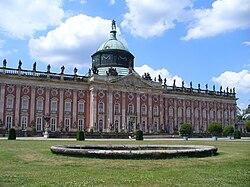
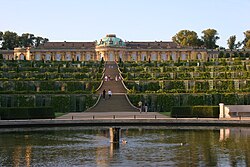


 KSF
KSF